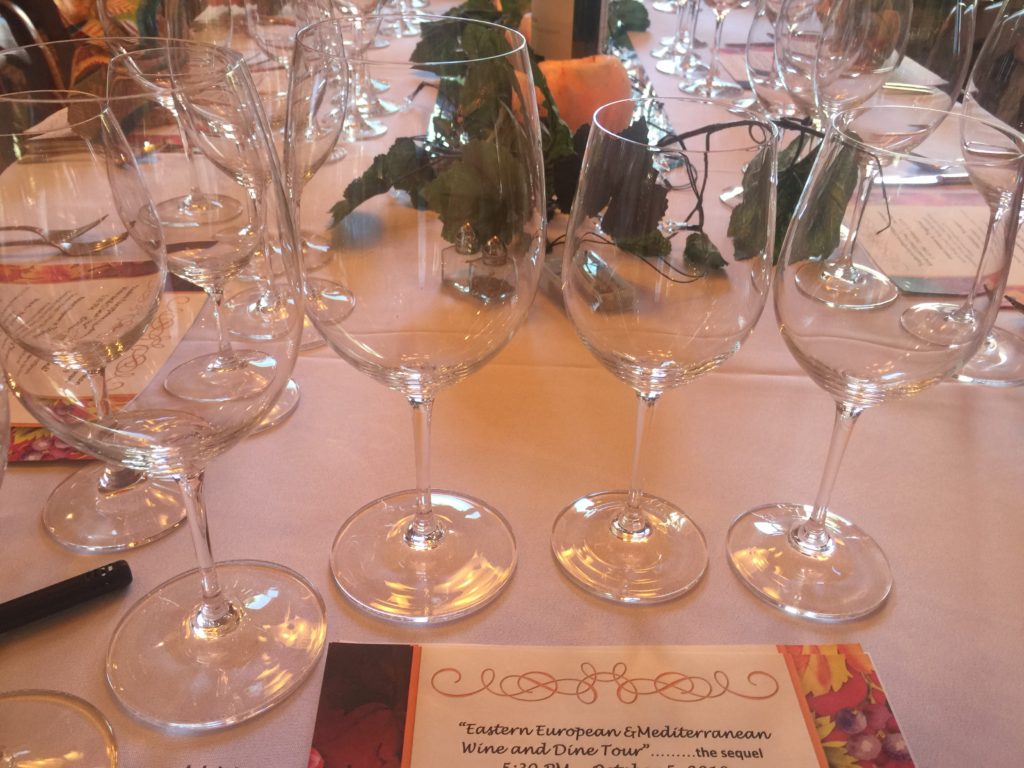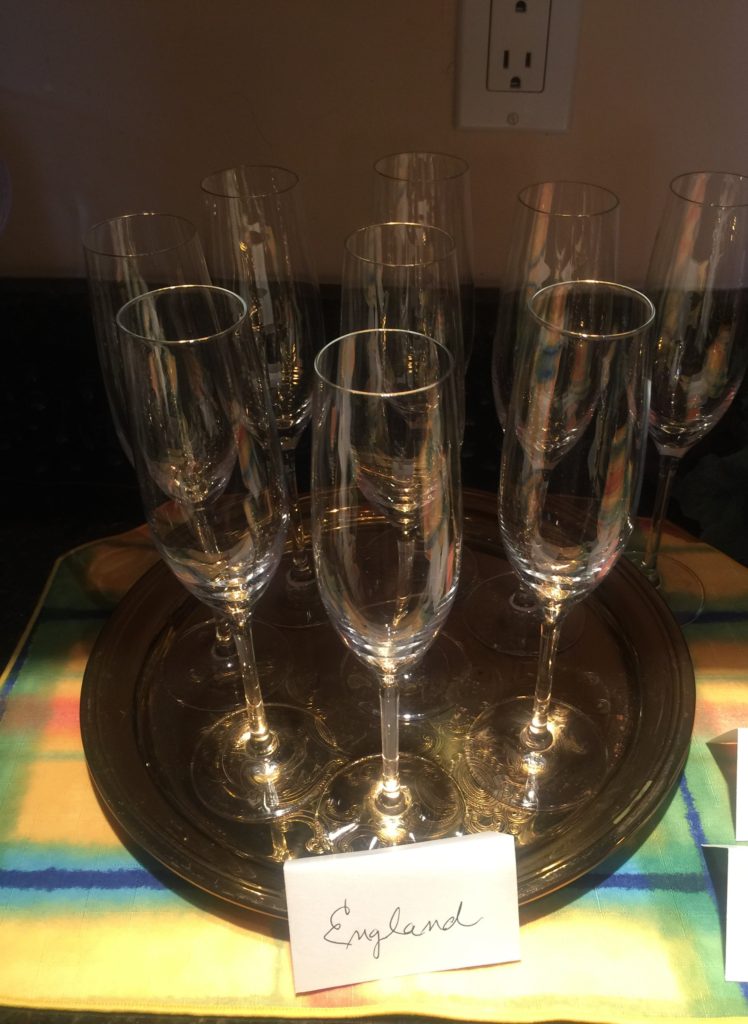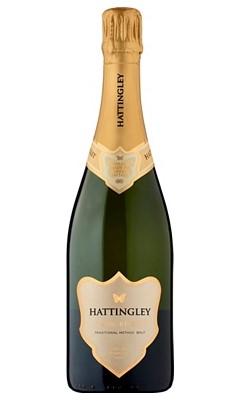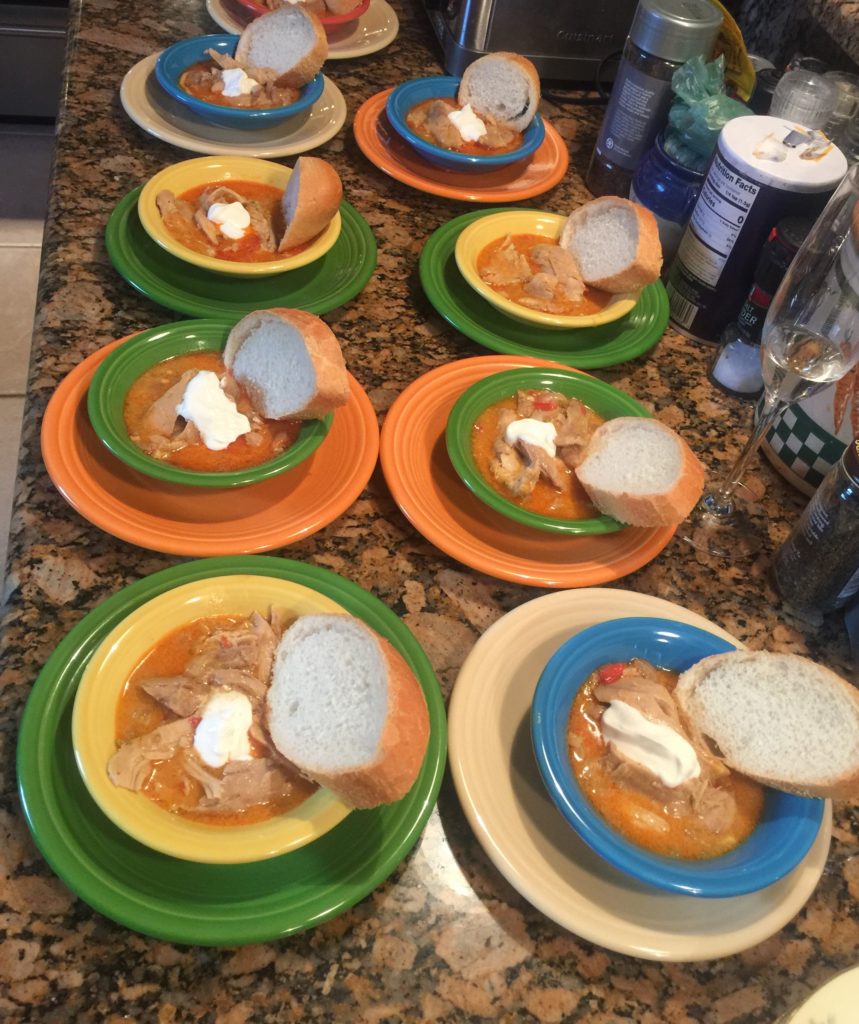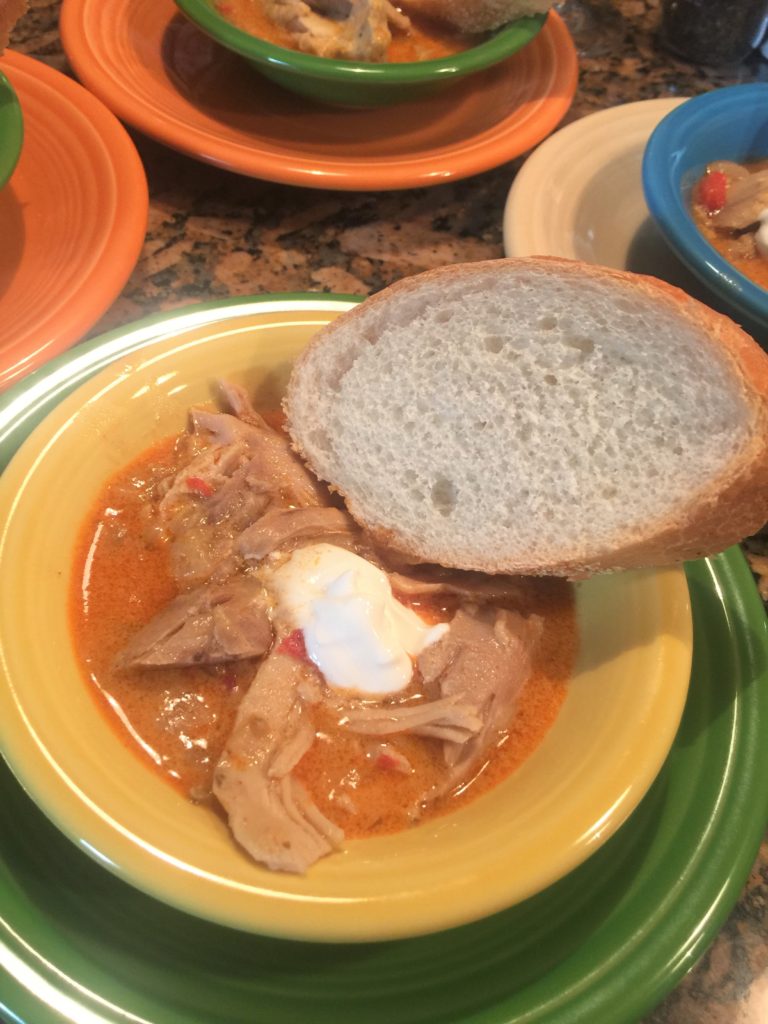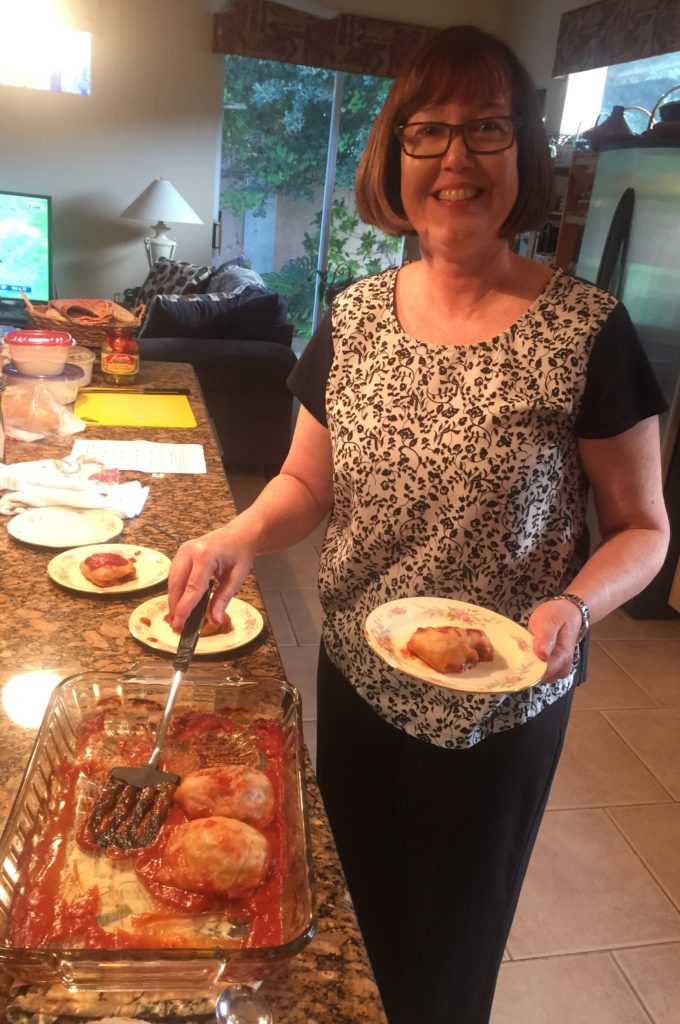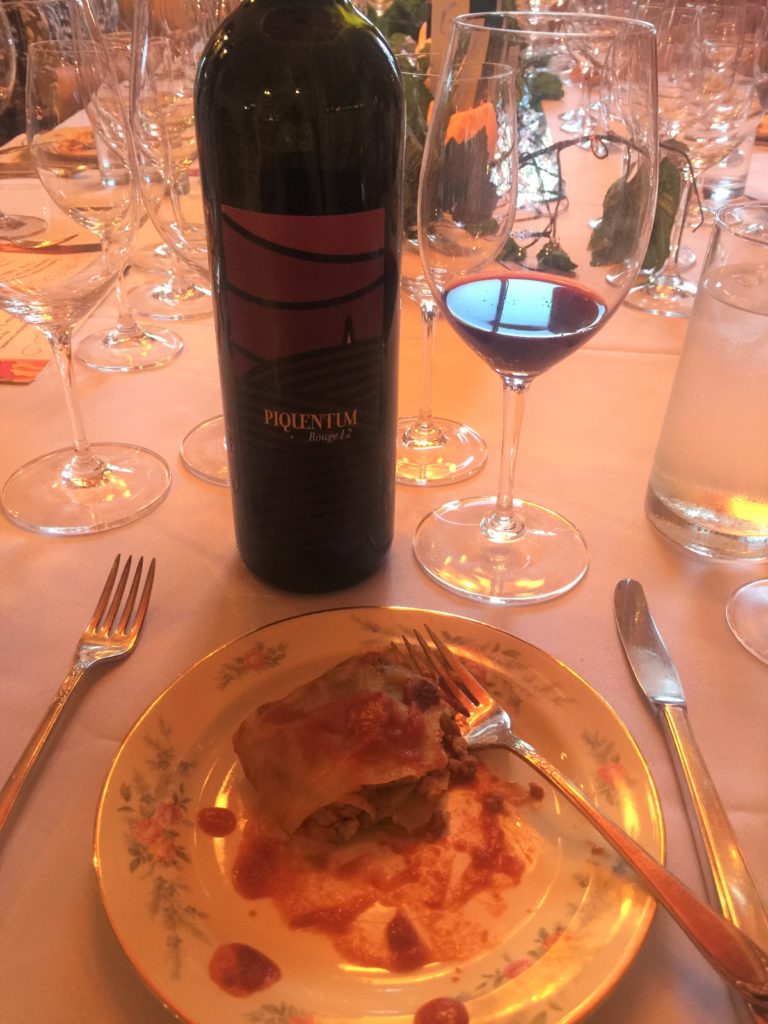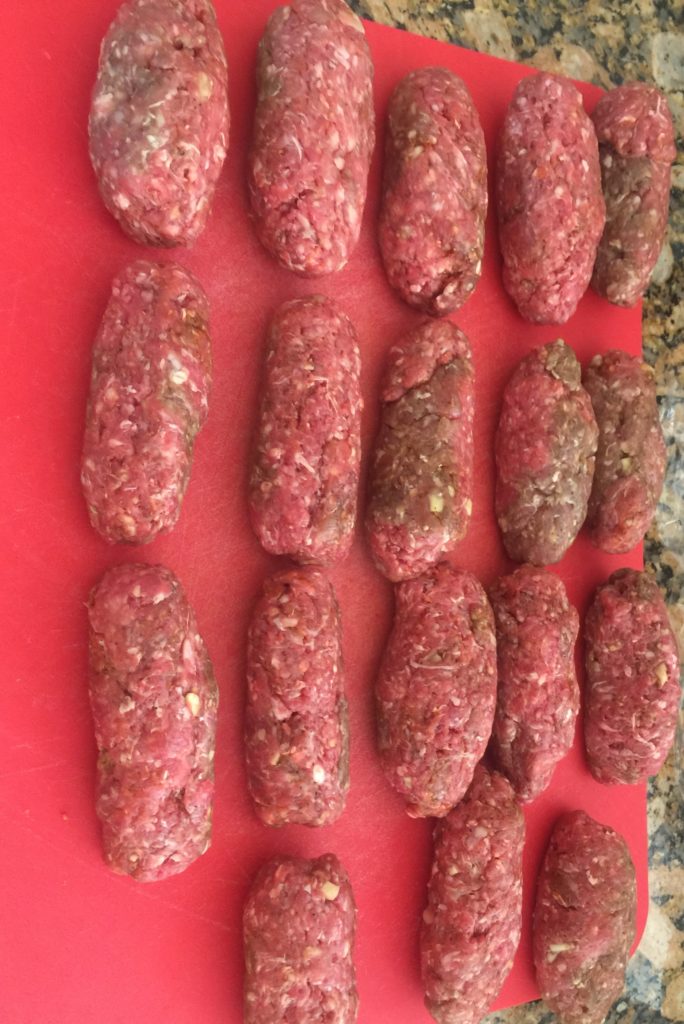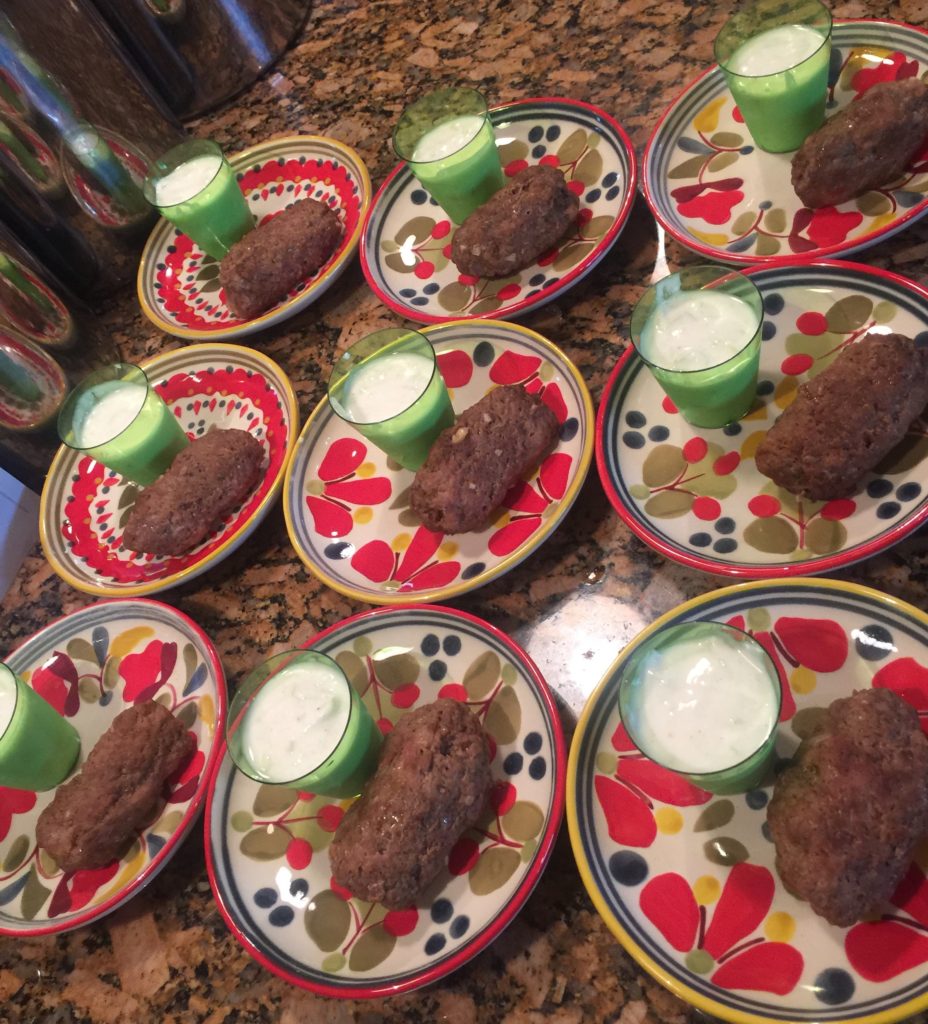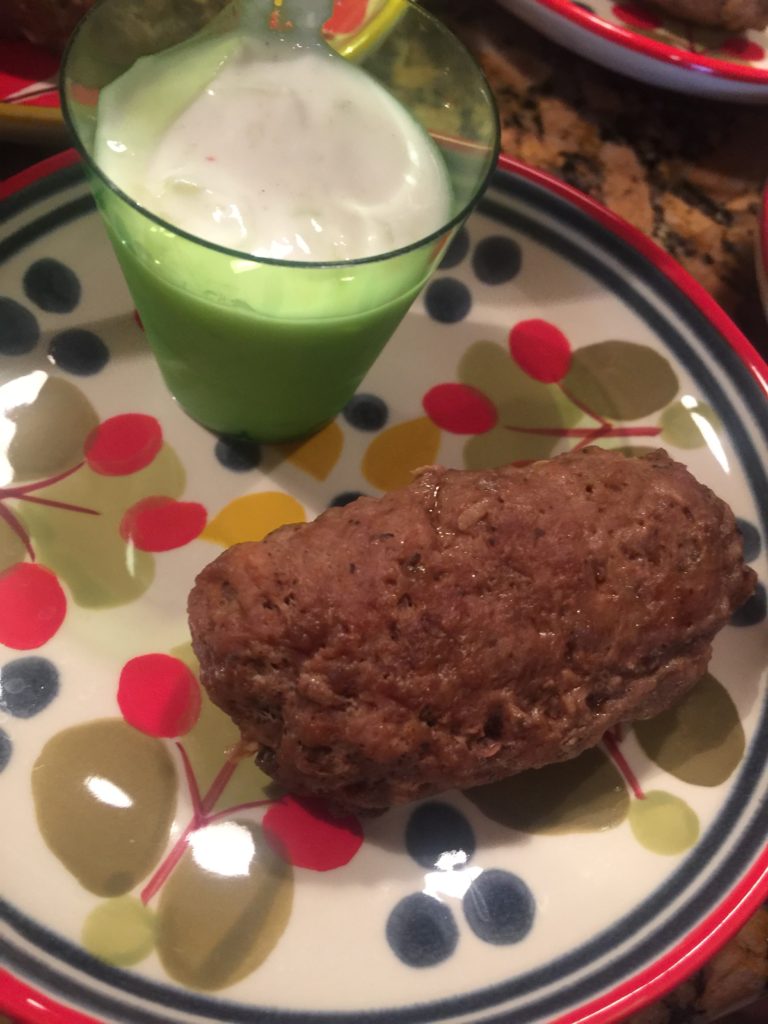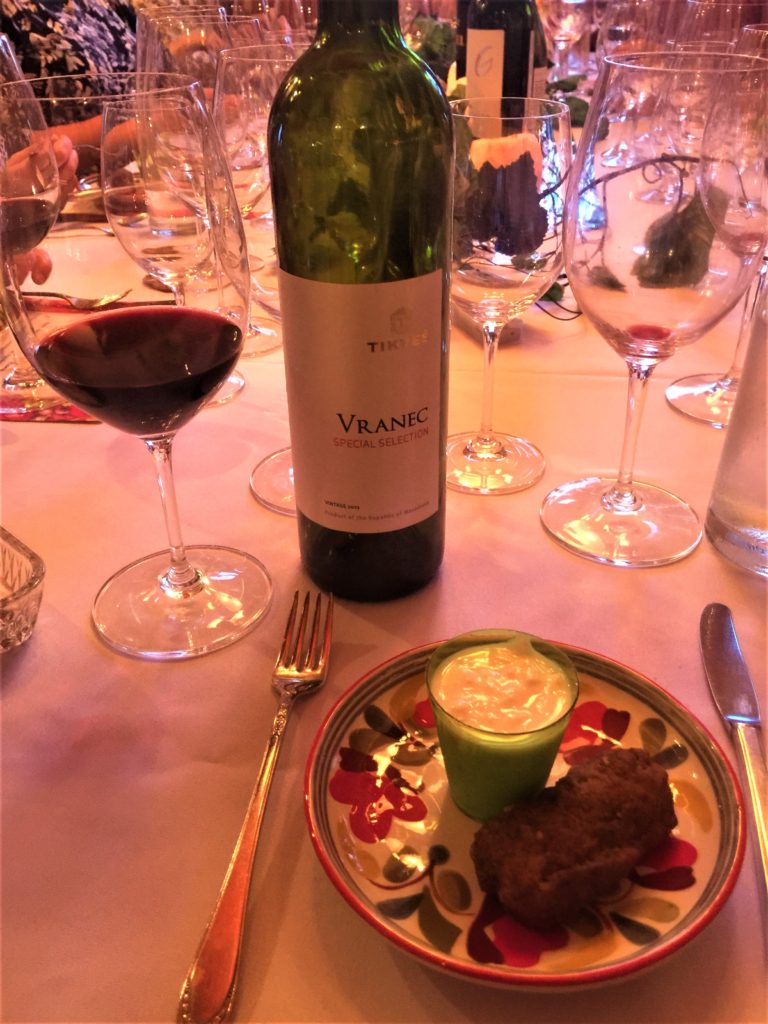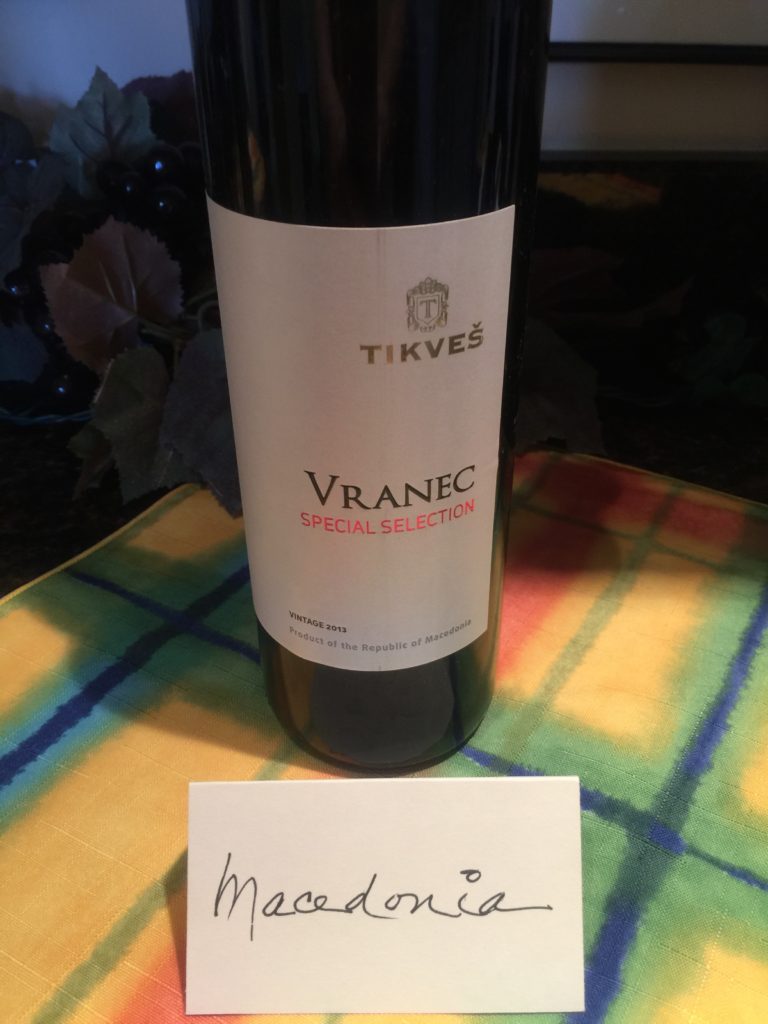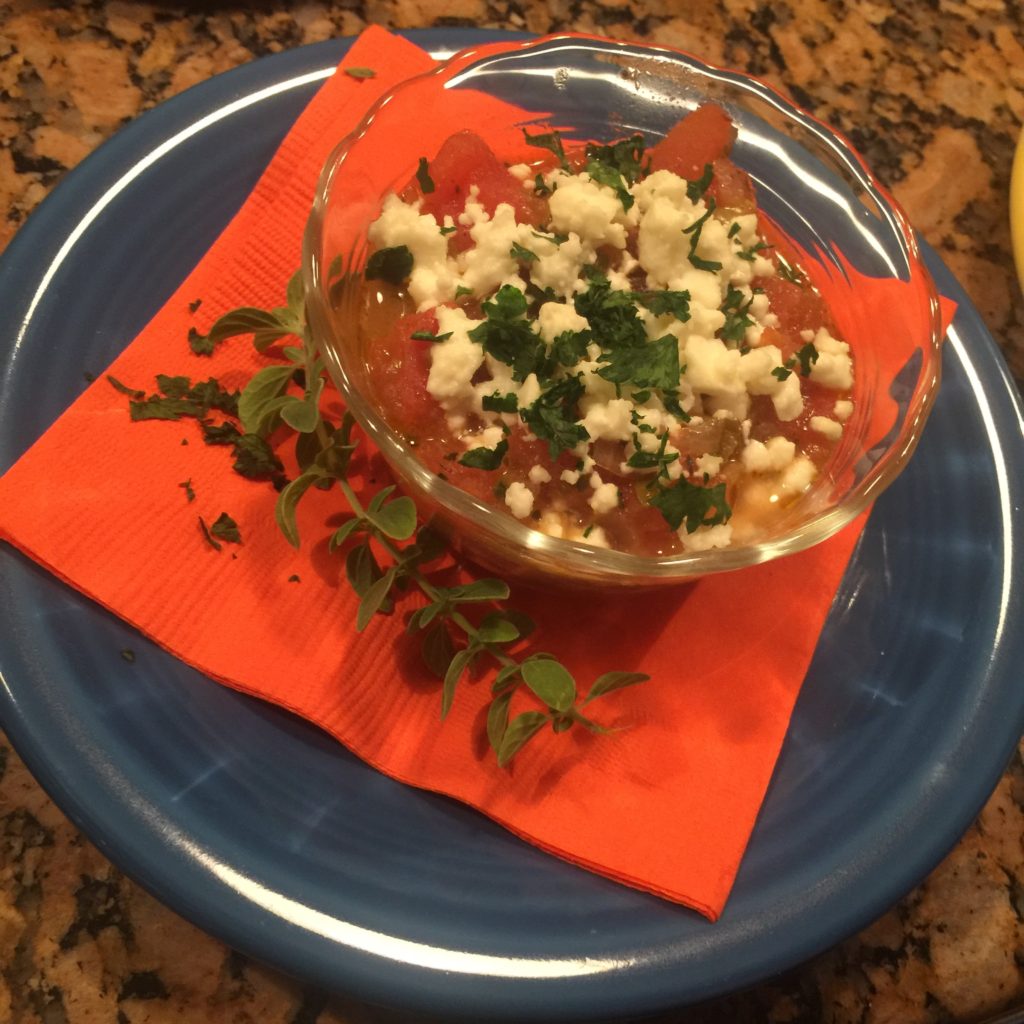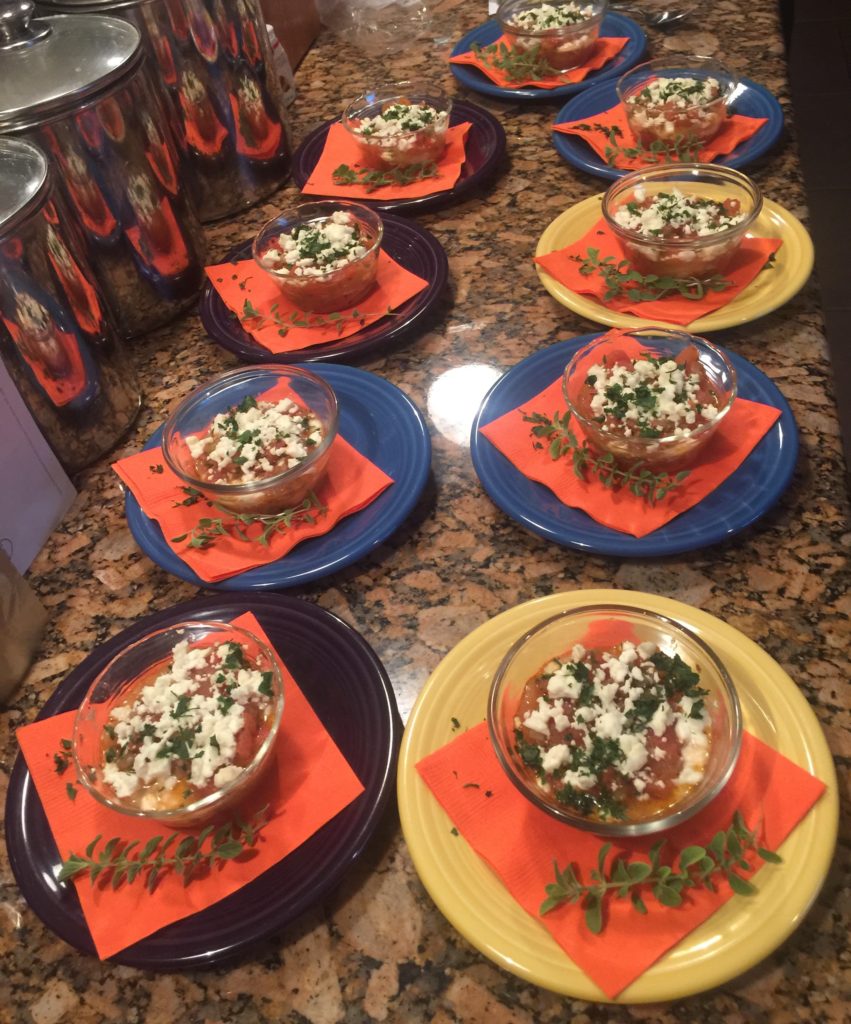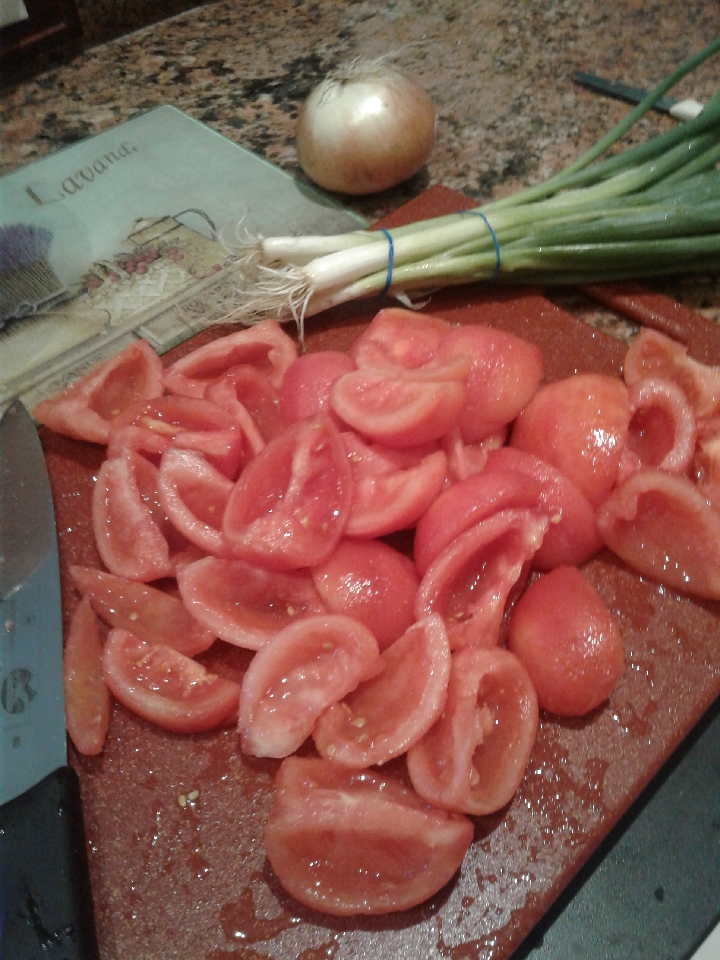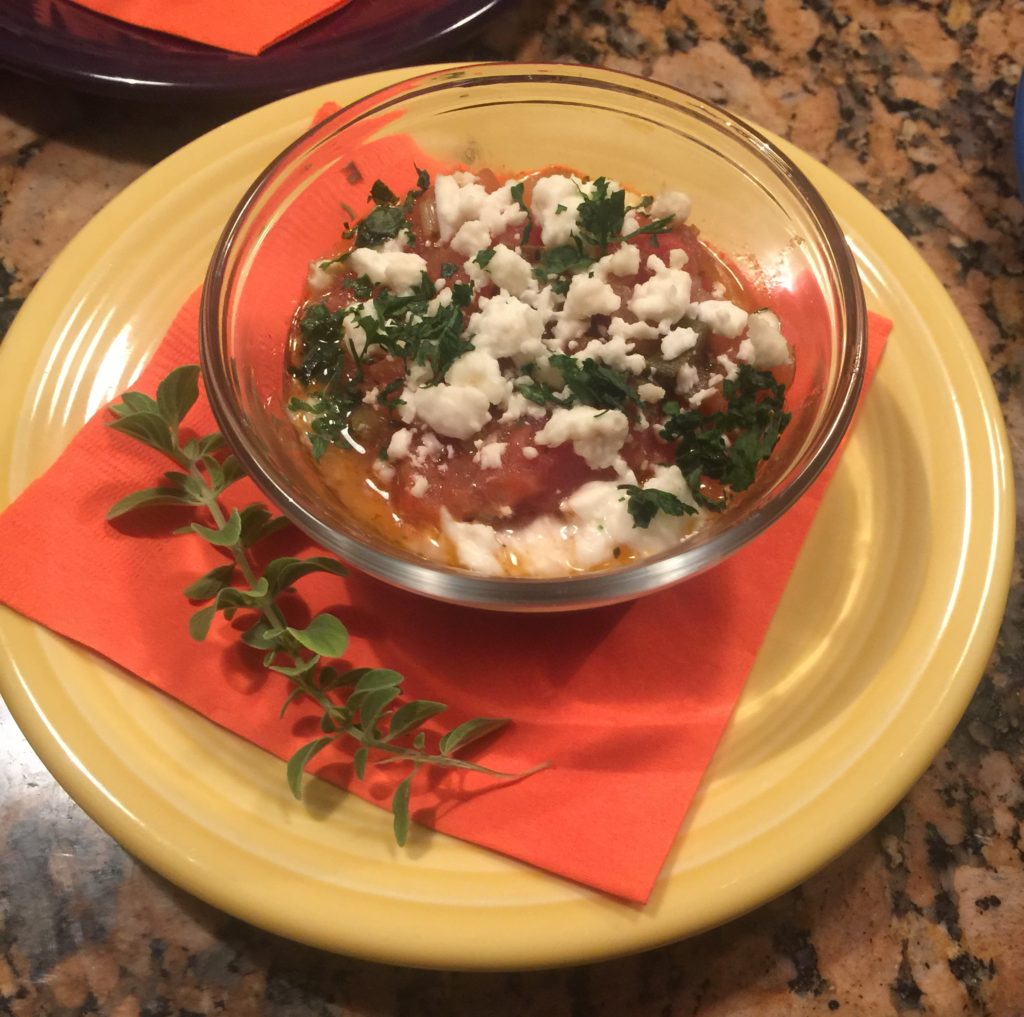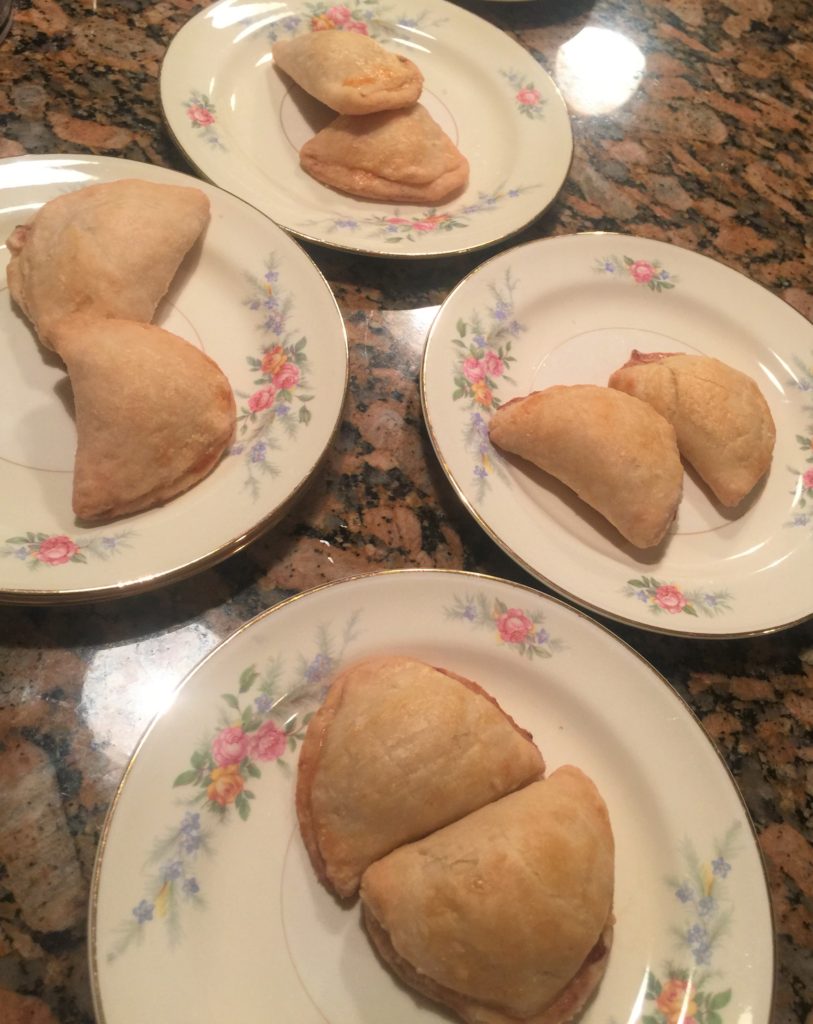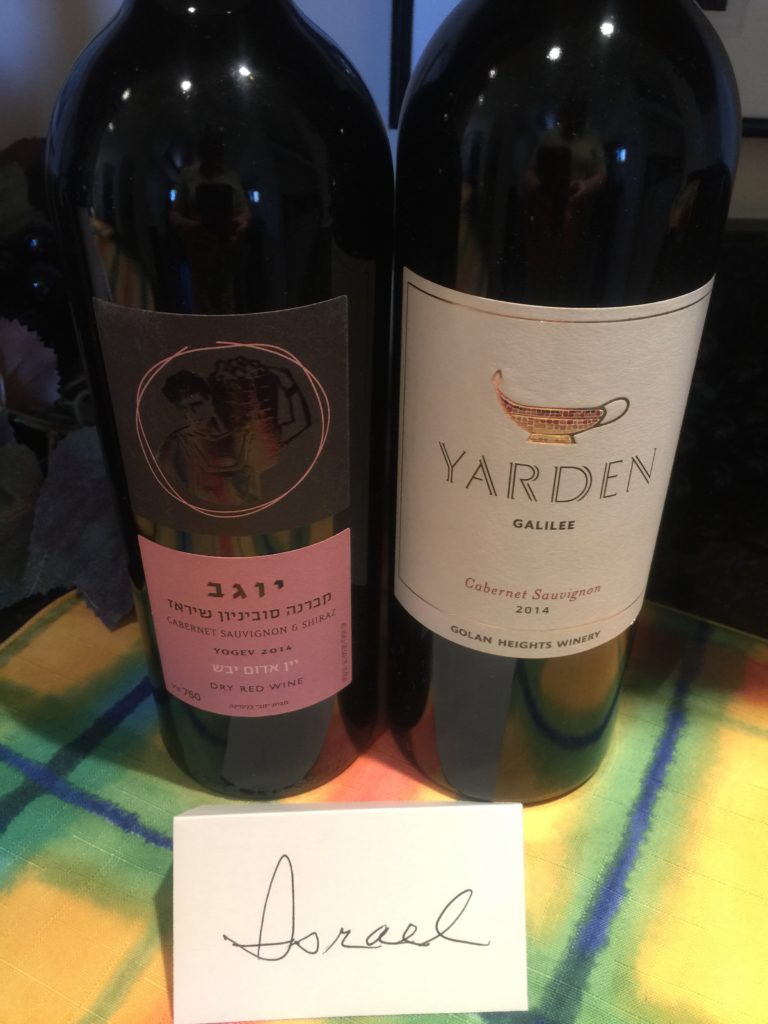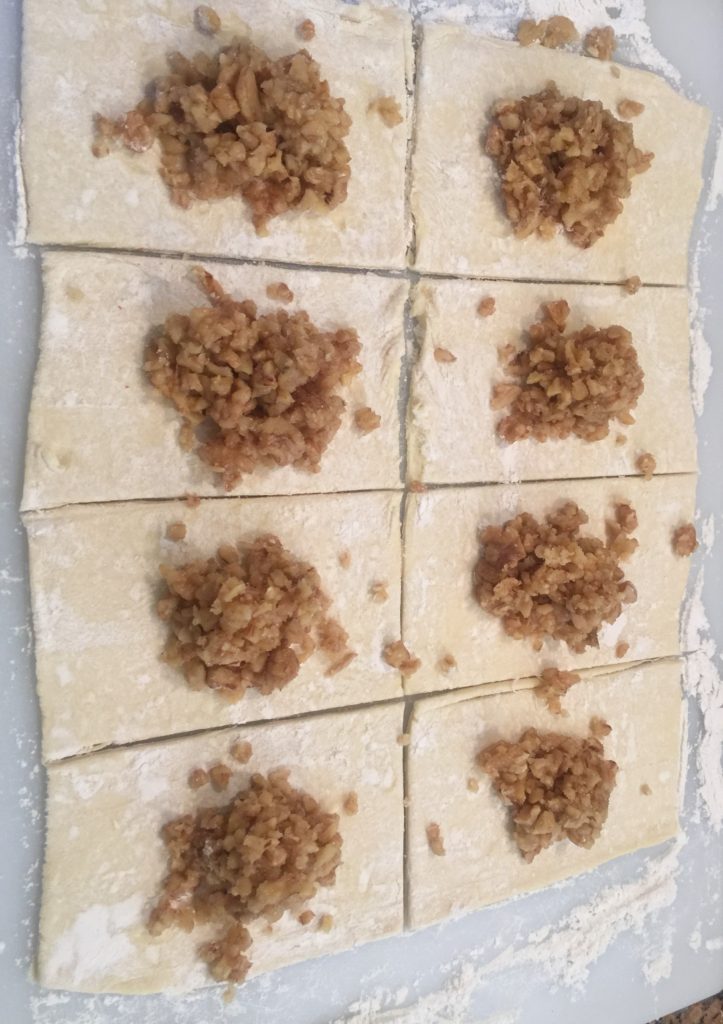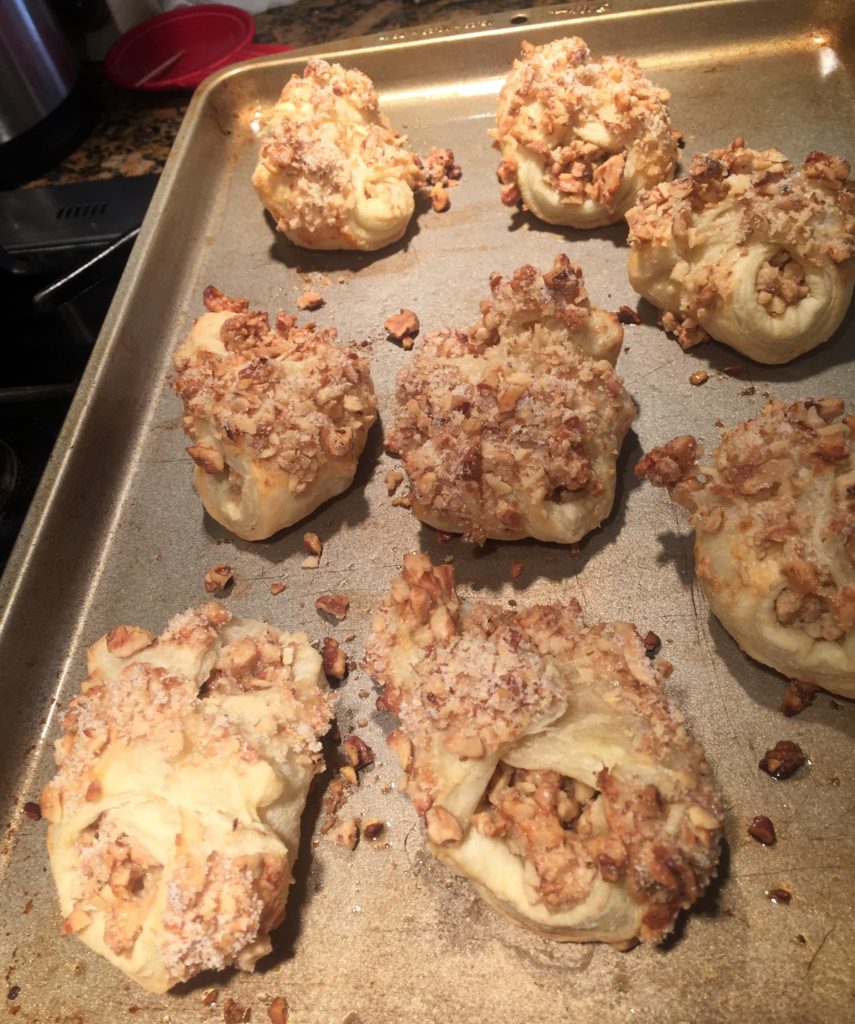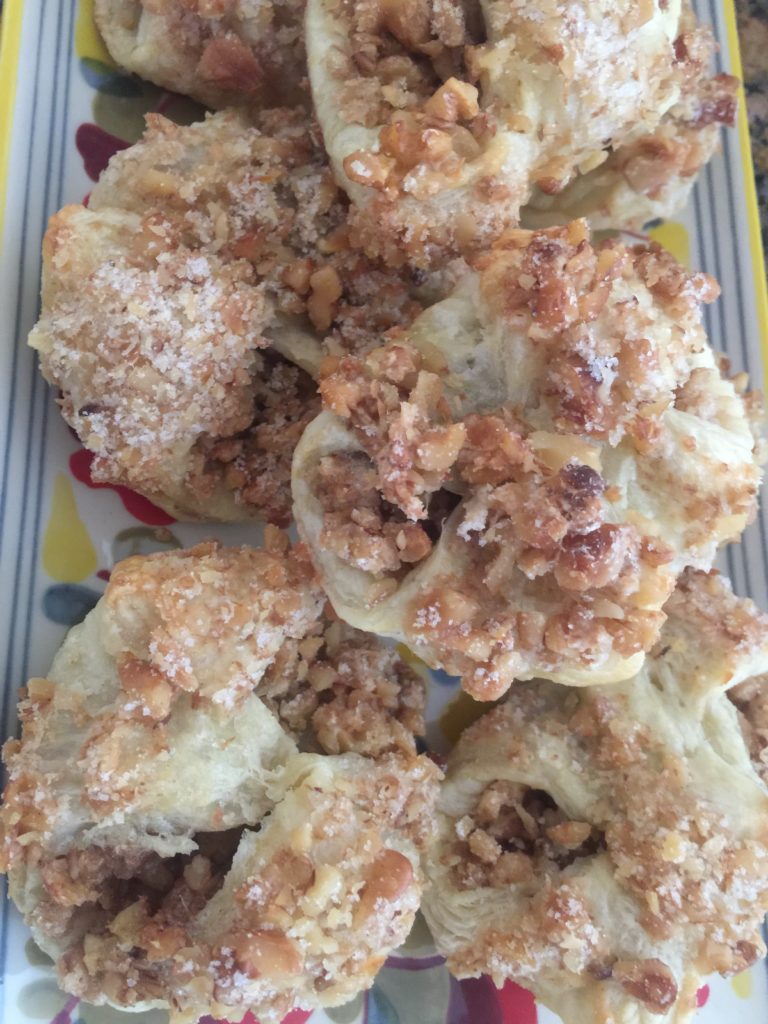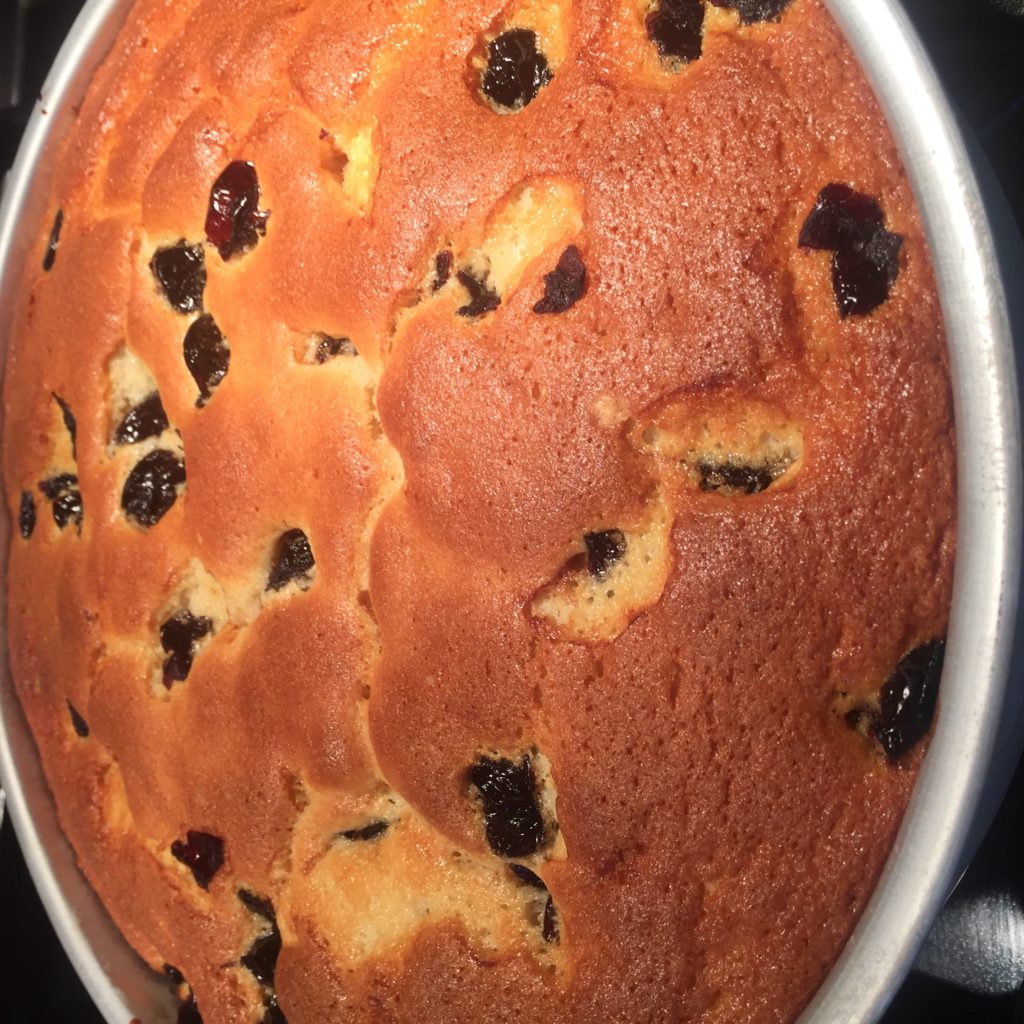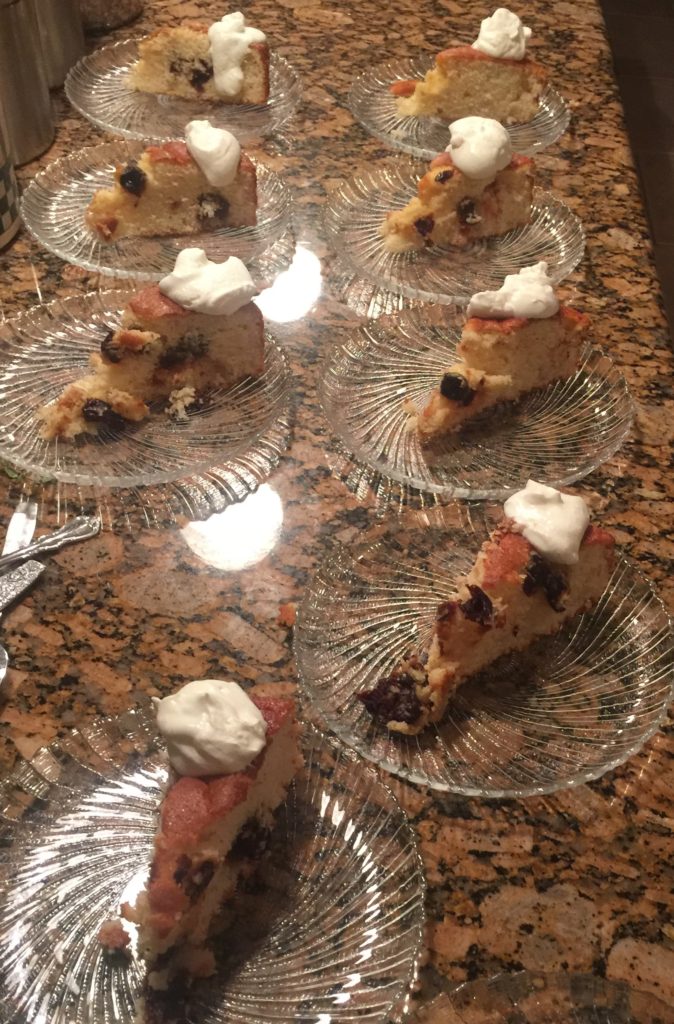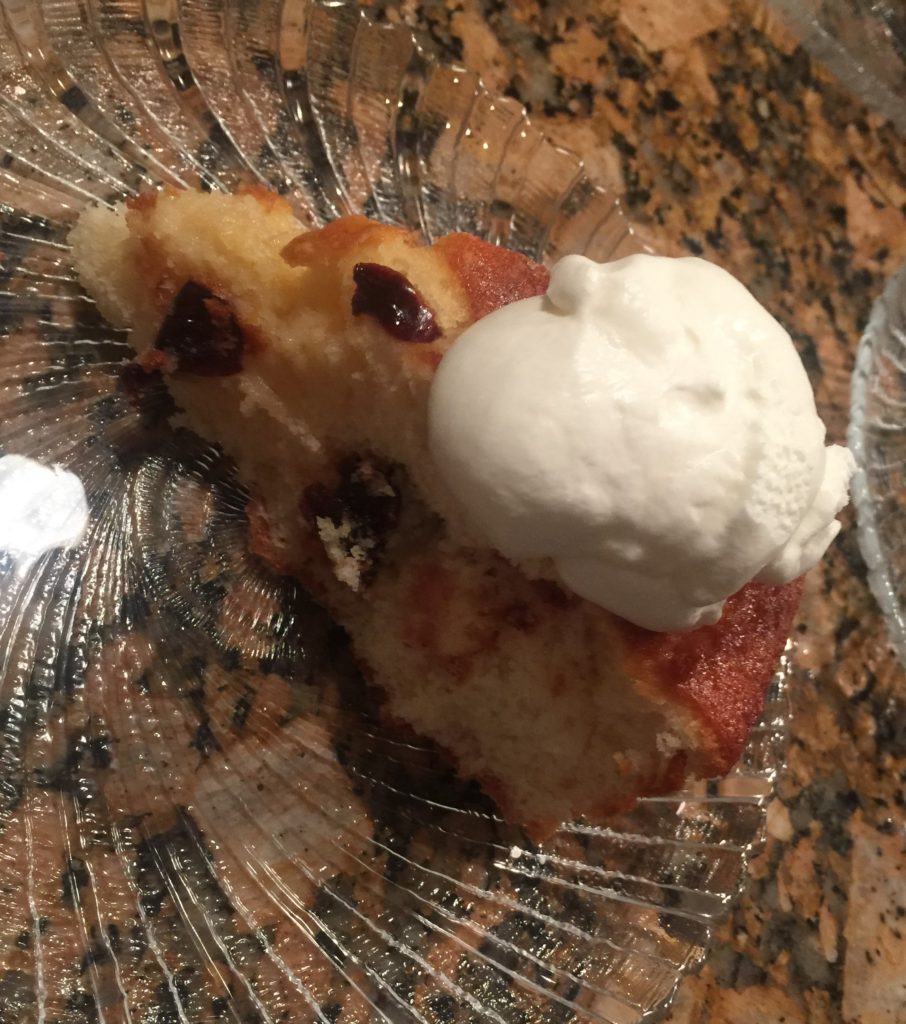While looking through the dusty recesses of my “forkandcorkdivine” CellarTracker wine inventory a few months back, I discovered some exciting, unique, fun and really amazing wines on the shelf. They were like “lonely leftovers” from wines I had ordered and served at several forkandcorkdivine events. There were wine dinners from Croatia, Hungary, Turkey, Macedonia, Lebanon, Israel and Santorini among numerous others. I’m always looking for unique themes for wine dinners to share with friends, and in the pop of a cork, “Eastern European & Mediterranean Wine and Dine Tour” the sequel was born! Those lonely leftovers would take center stage and assume the starring role that they deserved as they paired up with appropriate foods from their country of origin. And even better, they would be shared with people who have never had an opportunity to taste the varietals or at the very least, be familiar with the winery.
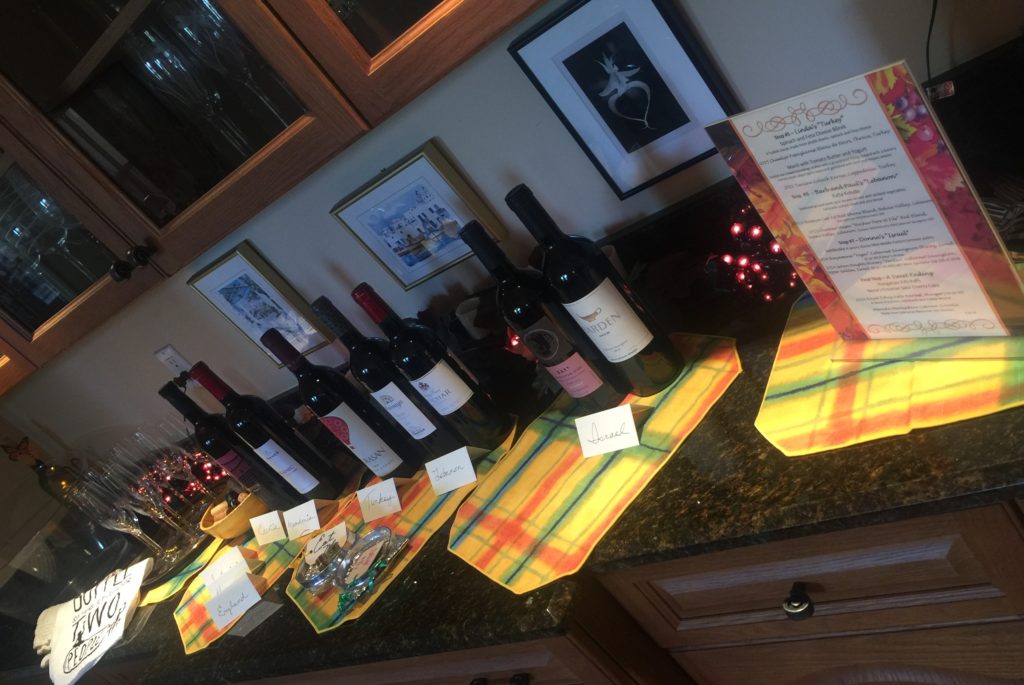
Seven countries and their representative wines were selected from our forkandcorkdivine inventory. We would return to Hungary, Croatia, Macedonia, Santorini, Turkey, Lebanon and Israel – quite an undertaking for one night’s dinner! Our participating and willing winelover guests each chose one of those countries for cooking up some culinary delights that would do their wine proud. When our wine dinner date finally arrived, everybody assembled (with their menu item in hand) to strategize about how best to complete each course. The welcome sparkling toast – or two – was poured, and we settled in for a fabulous experience. Here is how we traveled through those seven countries, the delicious foods we ate, and last but not least what unique and exciting wines we drank.
Chuck and Linda’s
“Eastern European & Mediterranean
Wine and Dine Tour”………the sequel
I have heard good things about sparkling wines currently being produced in England, and since the hostess has final say on the menu, we started our journey with a quick stop in England before heading on to Eastern Europe.
Airport Stopover in “England”
Savory Asiago Lemon Thyme Shortbreads
Hattingley Valley NV Classic Reserve Sparkling
Hampshire, England 92 pts WE
Hattingley Valley has been making sparkling wine in Hampshire, England since 2008. The soil is chalky and the climate ideal for sparkling wines. They use the traditional method for production and this Classic Reserve was made from 48% Chardonnay, 33% Pinot Noir, 17% Pinot Meunier and 2% Pinot Gris. It had hints of apricots and vanilla with some stone fruit, was creamy on the palate and crisp and fresh with a dry finish. We liked it a lot! This one was obviously a good choice for our first try at an English sparkling. Our trip was getting off to a great start!
The savory Asiago lemon thyme shortbread cookies were made from an Ina Garten recipe and were a perfect little mouthful to go with the Hattingley Valley. From the production standpoint, even better – you can make them several days in advance.
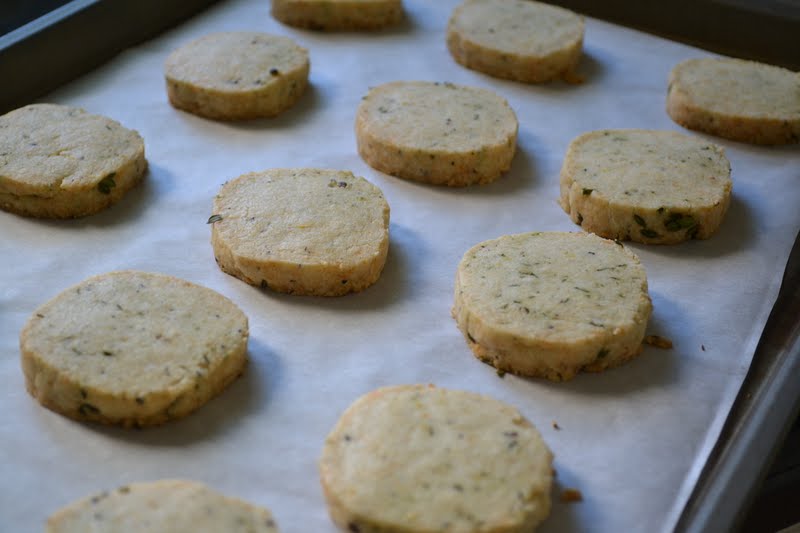
little appetizers, and you can make ahead!
Stop #1 – Helena’s “Hungary”
Chicken Paprikash
Chicken Paprikash is a classic Hungarian dish made from tender chicken and a rich creamy paprika-infused tomato sauce. Helena used boneless chicken to keep it easy for serving since our goal was to serve small plates. It is often served with Hungarian noodles, but again we were aiming for small servings. A slice of crusty baguette seemed perfect for sopping up that delicious sauce! A dollop of sour cream for extra flavor and good looks, and Stop #1 was ready to pair with our wine.
Oremus is one of the most famous wineries in Hungary and most famous for their Tokaji, the “wine of kings and the king of wines”. Bodegas Vega Sicilia bought Oremus a few years back and helped restore it to its former glory! Their 115 hectares of vineyards in the Tokaj-Hegyalja appellation grow in a stony clay soil similar to the central Loire Valley. They grow 50% Furmint, 20% Harslevelu, 20% Zeta and 10% Yellow Muscat. Oremus produces 375,000 bottles a year of which 226,000 are dry whites.
Our 2011 Oremus was a dry Furmint from the Mandolas Vineyard. The must was gently pressed, fermented in new wood barrels, then aged in 136-litre small barrels. This wonderful version of Furmint that we drank was bright straw gold in color, fresh and intense with spice, ripe white peaches and flower blossoms. It was dry on the palate with crisp acidity just as we would expect from volcanic soil. All in all, a great “Stop”! By the way, you can read about sweet Furmint wines later when we get to dessert.
2011 Oremus “Mandolas” Dry Furmint, Tokaji, Hungary
Stop #2 – Diane’s “Croatia”
Stuffed Cabbage Rolls
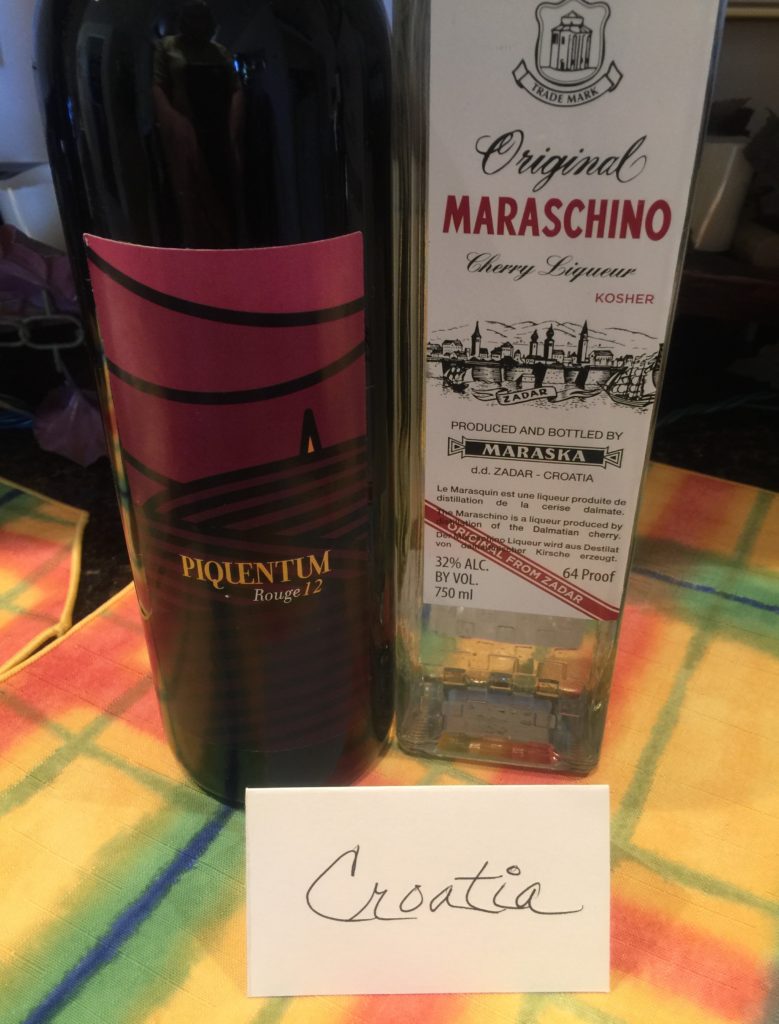
Stuffed cabbage rolls are made by cooks in many ethnic cuisines. They can have lots of variations, but Diane made hers in a traditional style with ground meat and rice filling rolled up in a cabbage leaf and cooked until tender with a homemade tomato sauce. They were quite tasty and a delicious pairing for our Croatian wine.
Piquentum wine is made by Dimitri Brečević who was born in Jurançon, French Basque Country, and after studying oenology in France and working in a number of wine regions, returned to his father’s homeland of Istria, Croatia. Istria is in the westernmost part of Croatia bordering on Italy and Slovenia. It is well known for grapes like Malvazija Istarska and Teran while the region of Dalmatia is known primarily for Plavac Mali. In 2006, Dimitri started his own winery in a converted concrete water tank near the town of Buzet. Piquentum currently has 4.5 hectares of vineyards: Malvasia 60%, Teran 20% and Refosco 20%. Grapes are hand-picked, and then slowly pressed without temperature control since it normally stays at 10-11 degrees C. all year long in the concrete tank. Wines go through “wild ferment” – no added yeast, bacteria, or additives. After a long and slow fermentation, the wines are bottled unfiltered with just enough sulfur added to help them make their journey across the Atlantic to us!
The 2012 Piquentum “Rouge” was made from the red grape Teran on organically farmed 25-50 year old vines. It was macerated 2-4 weeks and aged in wood barriques from 14-18 months. It was fragrant, and coated the inside of the glass like syrup while still being light bodied low alcohol with acidity that would have paired really well with the Croatian Prsut (prosciutto) that hangs from the ceiling of the winery. It did indeed have a pronounced iron and sanguine flavor, which is not a favorite of some wine drinkers, but our group found it enjoyable.
We will tell you more about the Maraschino cherry liqueur in the picture when we get to the sweet endings!
Note: If you would like to read more about the wines and foods of Croatia, here is the link to a previous posting on forkandcorkdivine https://www.forkandcorkdivine.com/?p=1113
2012 Piquentum “Rouge” Teran, Istria, Croatia
Stop #3 – Chuck’s “Macedonia”
Ćevapčići with Yogurt Sauce
Spicy little cigar-like sausages made of ground beef, pork and lamb with a yogurt cucumber dipping sauce
Ćevapčići is a grilled dish of minced or ground meat traditionally found in southeastern European countries. Croatia considers them a national dish, and we served them at our forkandcorkdivine Croatian wine dinner. Since they are also quite common in the Republic of North Macedonia and promised to pair very well with our wine, we decided to feature them at our Macedonian Stop #3. Chuck made his version of Ćevapčići from a mixture of ground beef, pork and lamb. They are supposed to be quite spicy, shaped into cigar-like sausages, grilled and served with a yogurt cucumber sauce or avjar. Chuck cut back on the spice a tiny bit in consideration of our guests varied preferences.
Our Macedonian wine was truly a super star. Much to our amazement, Saturday October 5 – the very day of our wine dinner – was the first Vranec World Day! This was especially exciting for us as the Republic of North Macedonia is the largest wine producer of the grape variety Vranec.
The word “Vranec” means strong, black and powerful horse, the black stallion, and the wine made from the Vranec grape is an intense dark red in color. The grape came from Montenegro in the 1950s, and Macedonia now has the most Vranec plantings in the world.
Tikves, which is also the name of the wine region, has been making wines over 120 years. It is the oldest winery in Macedonia beginning in 1885. Today it is very modern and innovative right down to using solar panels for self-sustainable energy and recycling waste into fertilizer. We served Tikves Bela Voda wine at a previous dinner. The Vranec was blended with Plavec and it was excellent.
Our 2013 Tikves “Special Selection” Vranec was sustainably farmed on 30 year old vines, aged for 12 months in premium quality French oak barrels which gave it aromas of overripe berries and dry plums with hints of oak, smoke, chocolate and fresh spices. Robert Parker’s Wine Advocate gave it 90 points. The Tikves Vranec was the favorite of some of our guests. It was indeed a superstar with it’s own special Vranec World Day!
2013 Tikves “Special Selection” Vranec, Tikves, Republic of Macedonia, 90 pts WA
Note: If you would like to read more about the wines and foods of Macedonia, here are links to previous postings on forkandcorkdivine https://www.forkandcorkdivine.com/?p=1621 and https://www.forkandcorkdivine.com/?p=1589
Stop #4 – Anita’s “Santorini”
Shrimp with Feta Cheese (Garides Youvesti)
Shrimp baked with tomatoes and Feta cheese is a classic Greek dish. Garides Youvesti as it is known in Greece, is usually served in an earthenware dish called a youvetsi. Anita started her classic version with shrimp, scallions, peeled and seeded tomatoes and white wine on top of the stove; then placed in individual ovenproof ramekins. They were topped with crumbled feta cheese and baked in the oven just before service until everything was hot and that delicious cheese was lightly melted. What a treat was in store for us paired with two excellent Assyrtikos!
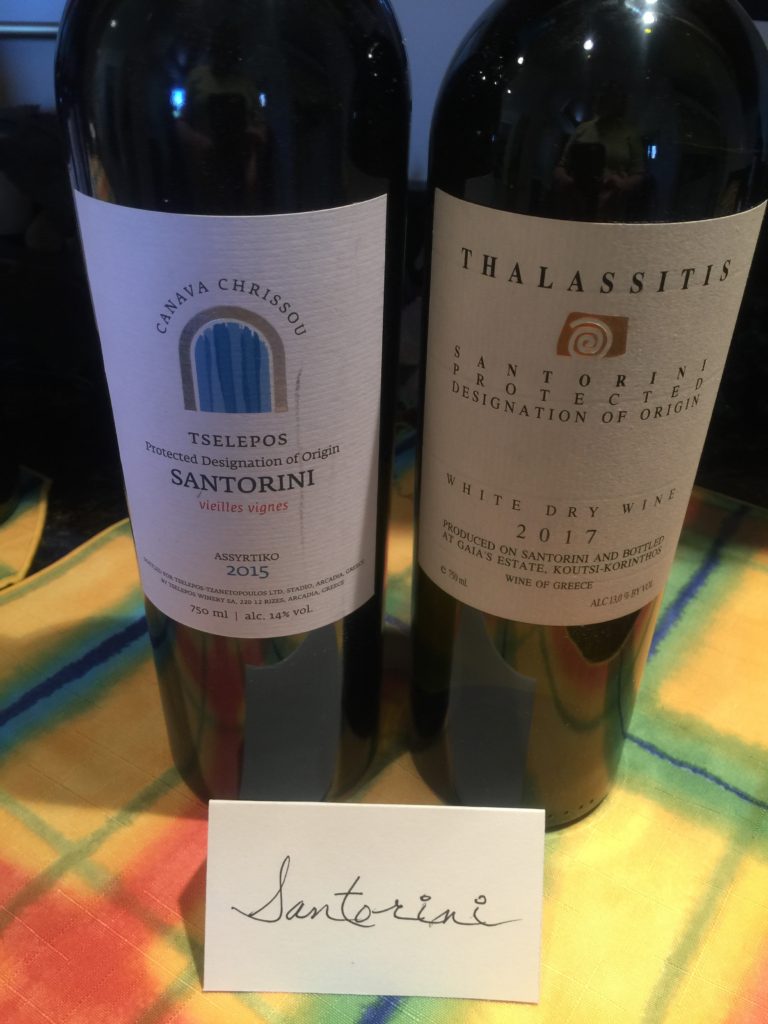
We first tasted and quickly came to love Assyrtiko wines a few years ago. It is indigenous to the Greek island of Santorini where it’s roots have to scavenge water from 30-40 feet below the soil. Lucky for us, this usually makes the wine unusually good! Assyrtiko maintains high acidity and higher alcohol than most whites and is intensely dry with citrus notes and high minerality. After all it is a volcanic wine, sitting on a very big rock right out there in the middle of the water! You can drink it young or age it.
The 2015 Tselepos “Canava Chrissou” is one of the best examples of Assyrtiko. Its pale yellow in color, very concentrated with flavors of lemon and lime peel and a touch of sea salt on the finish with 13.5% alcohol. Robert Parker’s Wine Advocate gave it 94 points and Wine Enthusiast 92 points. This was our last bottle of six purchased a few years back, and it was still a great wine.
Since it is always good to have a backup plan, we opted to serve two great examples of Assyrtiko. GAI’A (Yay-ya) is one of the pioneers of the modern Greek wine revolution. Gai’a was established in 1994 by Leon Karatsalos and winemaker Yiannis Paraskevopoulos who wanted to show off Santorini indigenous grapes to their best by merging traditional methods with innovative techniques. “Thalassitis” means “originating from the sea” in Greek, comes from 70-80 year old vineyards and is the flagship white of Gai’a. Our 2017 Thalassitis was made from hand harvested grapes, destemmed and pressed, macerated with skins at 50 degree F for 12 hours, then fermented in stainless steel tanks. It gave us flavors of stone fruit, wild honey and salt air just as promised. Our wines were indeed worthy of Anita’s shrimp dish for Stop #4.
Note: Since volcanic wines have already been referenced several times, here are links to articles about forkandcorkdivine volcanic wines dinner: https://www.forkandcorkdivine.com/?p=985 and https://www.forkandcorkdivine.com/?p=918
2015 Tselepos “Canava Chrissou” Assyrtiko, Santorini, Greece 92 pts WE
2017 Gaia Estate “Thalassitis” Assyrtiko, Santorini
95 pts Robert Parker; 94 pts W & S; 90 pts WE
Stop #5 – Linda’s “Turkey”
Spinach and Feta Cheese Bὂrek
A Turkish classic – phyllo sheets, spinach and feta cheese
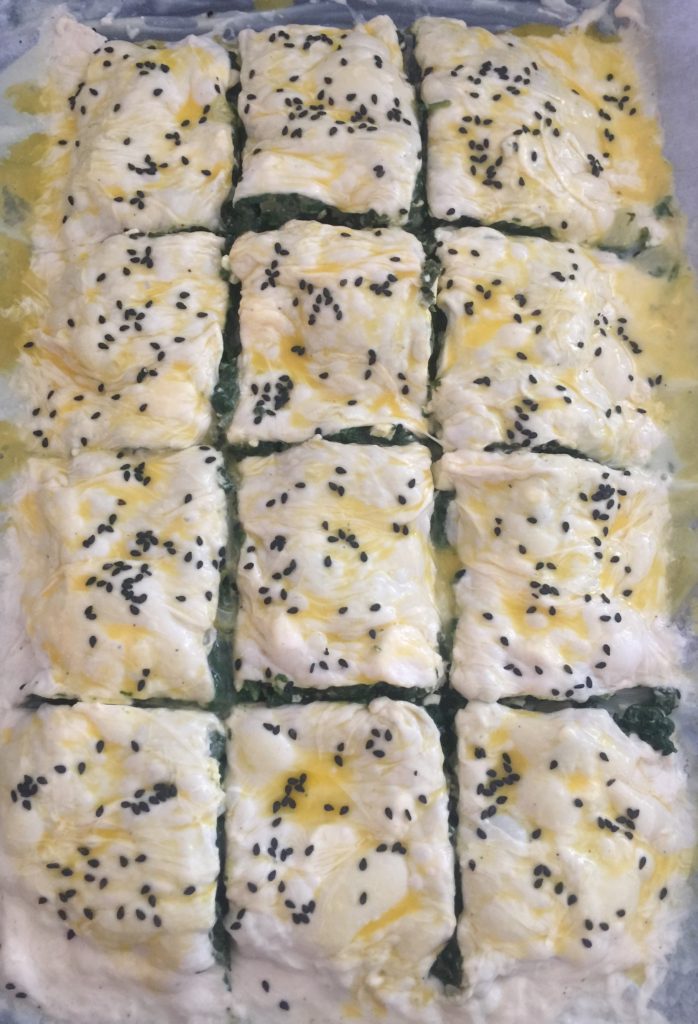
Borek ready for baking. 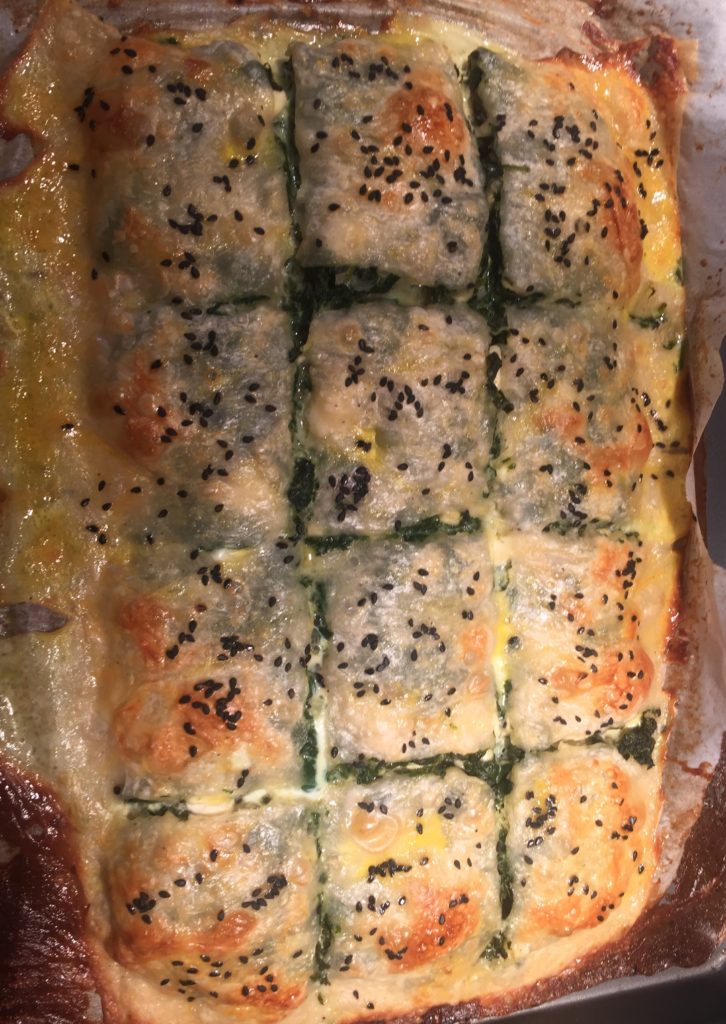
Borek hot out of the oven! 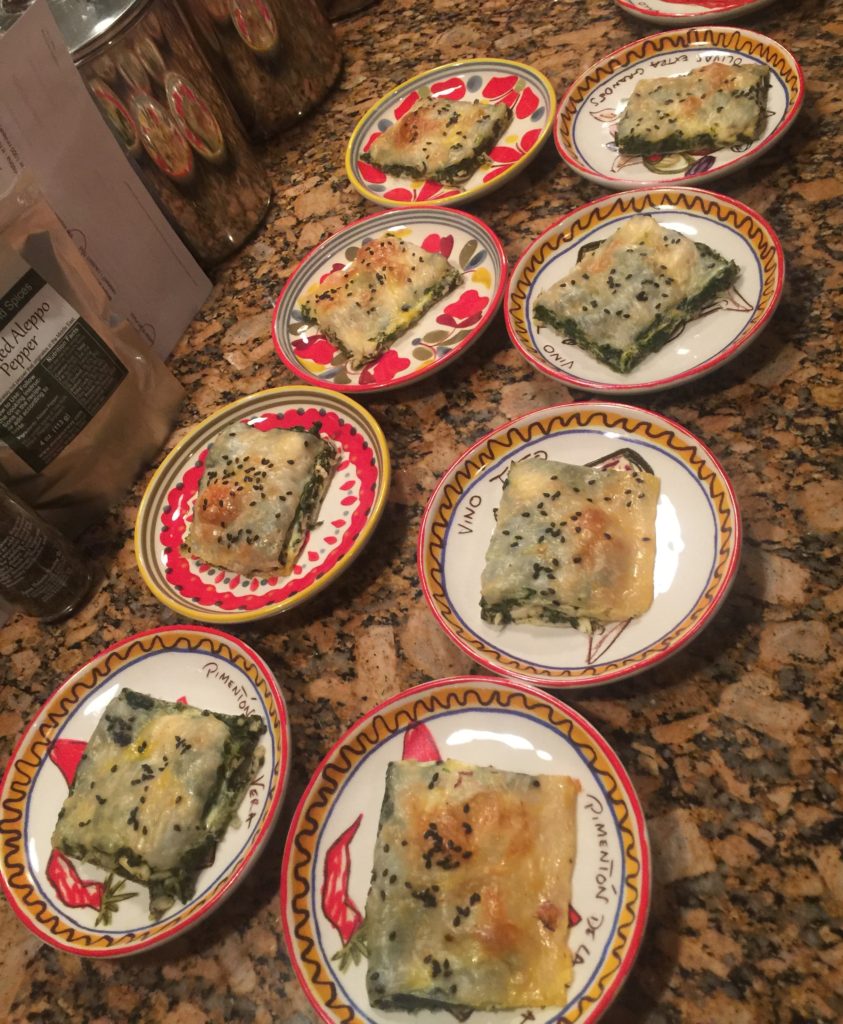
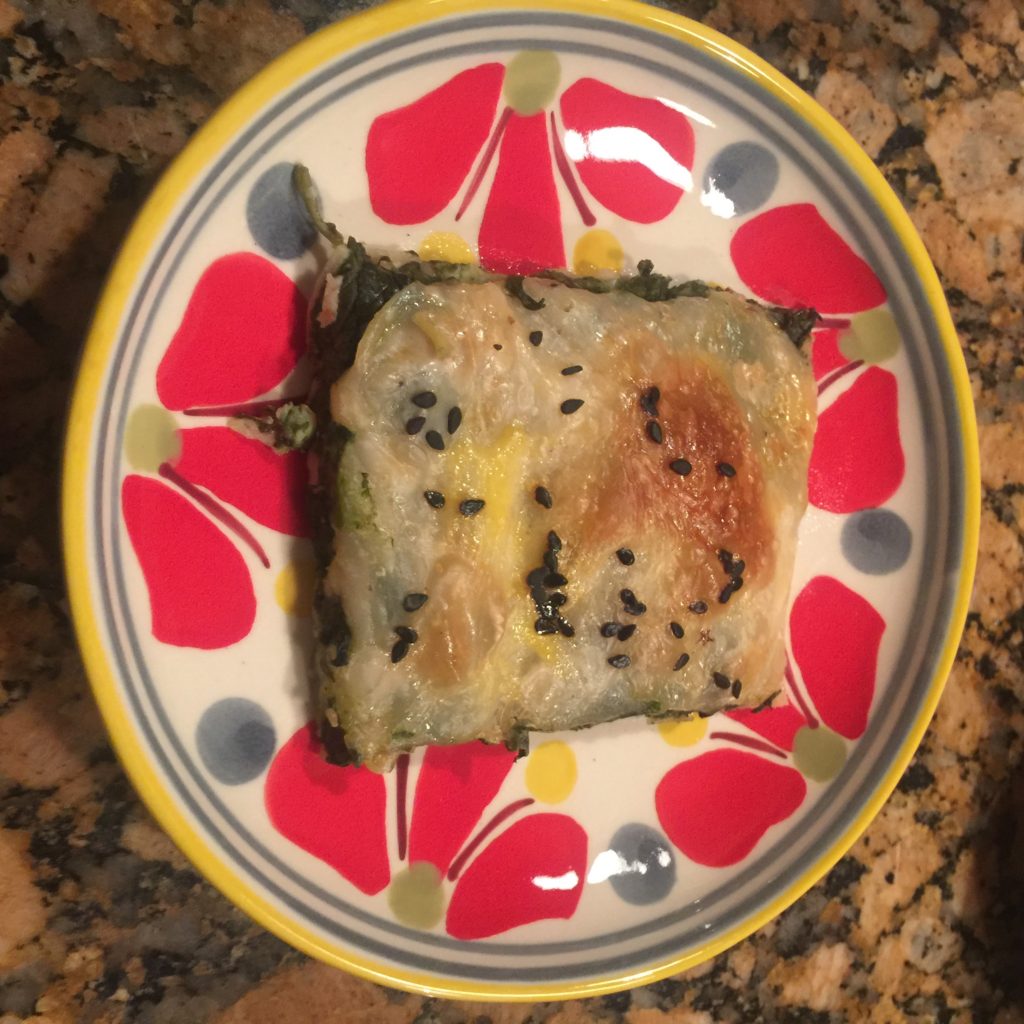
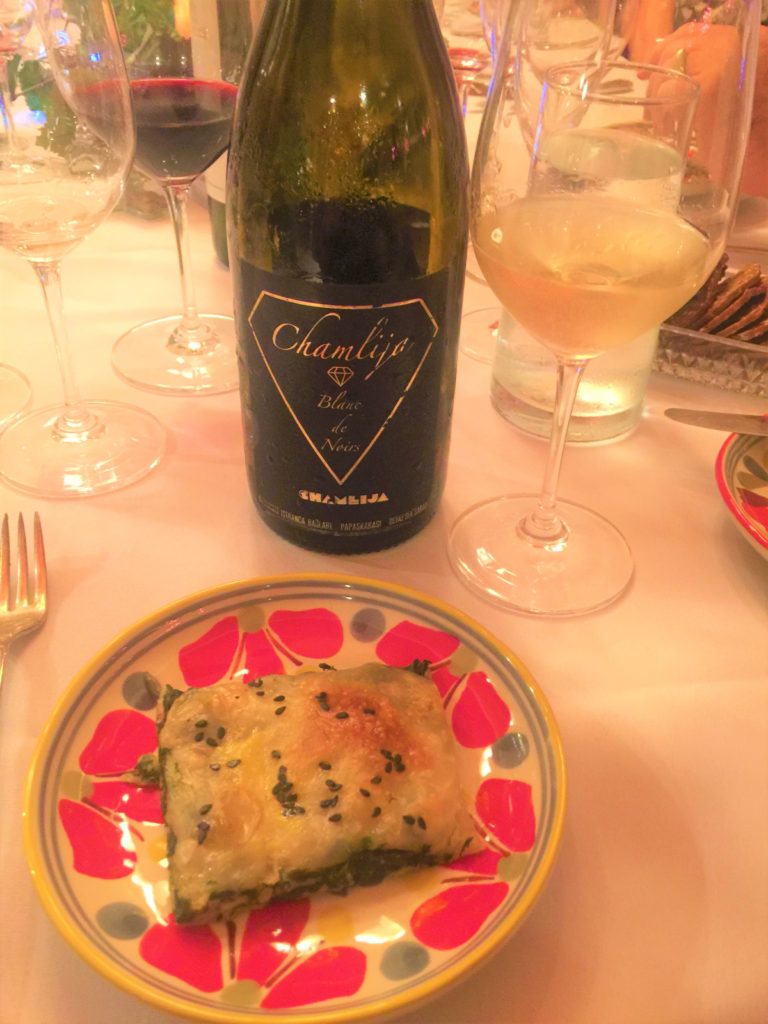
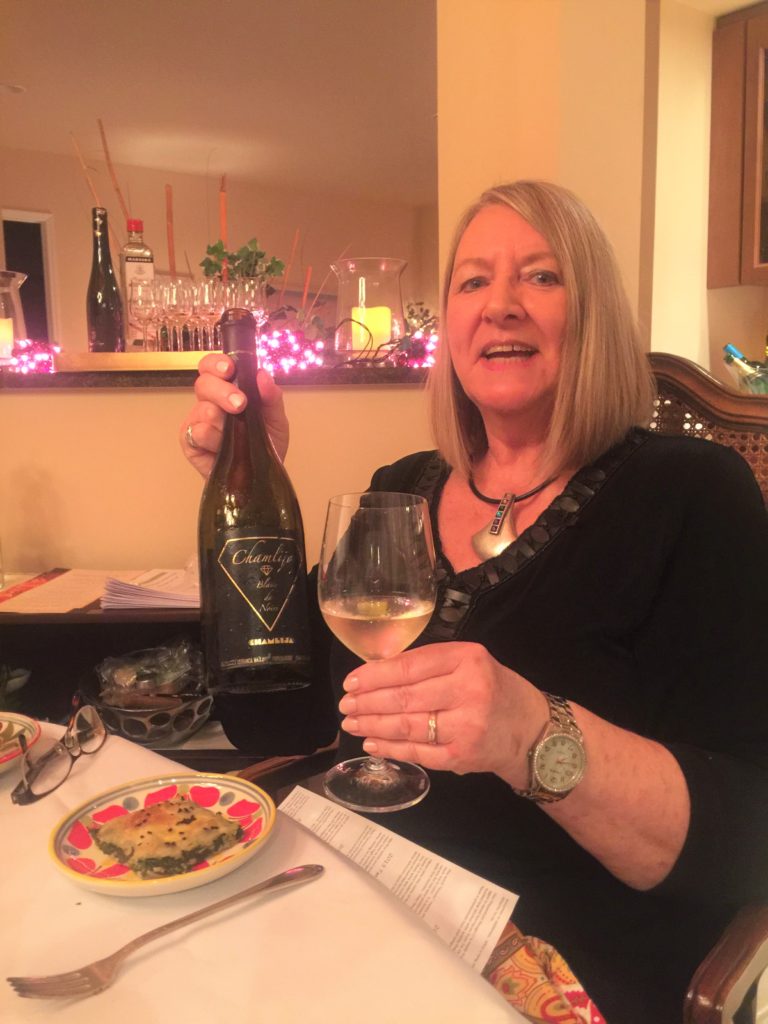
Cheers to Chamlija!
Bὂrek is a pastry made of thin flaky dough, quite often phyllo; filled with cheese, spinach, or ground meat; then baked. You will find it in Turkey, the Balkans, Caucasus, and countries all around the Mediterranean and Eastern Europe. I made a classic Turkish version of fresh spinach, onion and feta cheese filling. Luckily purchased sheets of phyllo dough work really well. Just keep layering them, add that fresh spinach filling between the layers, painting them with a yogurt and milk egg wash as you layer. Brush the top with egg yolks, then sprinkle with black and white sesame seeds. Bake till golden brown and enjoy!
2015 Chamlija Papazkarasi Blanc de Noirs, Thrace, Turkey
Turkey has a wine history dating back to 7000 BC, but 80% of Turks have never touched wine. They are Muslims and alcohol is considered “haram” or prohibited. They grow a lot of grapes in Turkey but have no system for wine, standards or appellations. Wineries were state run until 2004. In spite of all this, Turkish wine quality has been steadily improving and winning awards. Of the 600-1500 indigenous grapes, 30-60 are grown commercially. Boğazkere, Öküzgözü, Kalecik Karasi and Narince are some of the grapes to know. Through our favorite wine travelers and authors of “Exotic Wine Travel”, Matthew Horkey and Charine Tan, we came to know and love Chamlija (chahm-lee-zjah), a certified sustainable winery making promising wine from both indigenous and international varieties. Mustafa Camlica is the owner and his daughter Irem, a renowned Turkish artist, makes the artistic labels that appear on Chamlija wine bottles.
Sadly this bottle of 2015 Chamlija Blanc de Noirs from Thrace, Turkey was the last of our Chamlija wine. It was a lightly pressed white version of the indigenous Papazkarasi grape grown high on the Strandja Massif near where European Turkey meets Bulgaria, also known as Thrace of the Marmara Turkish wine-growing region. Mustafa’s family has been growing grapes in the area since 1936. The wine was pale straw in color with a nose of lemon, flavors of lemon and peach and a refreshing finish. It was fermented in stainless steel and only 420 cases were made. We are delighted to know that one bottle found its way to us right here in Southwest Florida!!!
Manti with Tomato Butter and Yogurt
Turkish star-shaped dumplings stuffed with a ground beef filling, topped with a buttery tomato sauce, yogurt garlic sauce and garnished with mint and Aleppo pepper
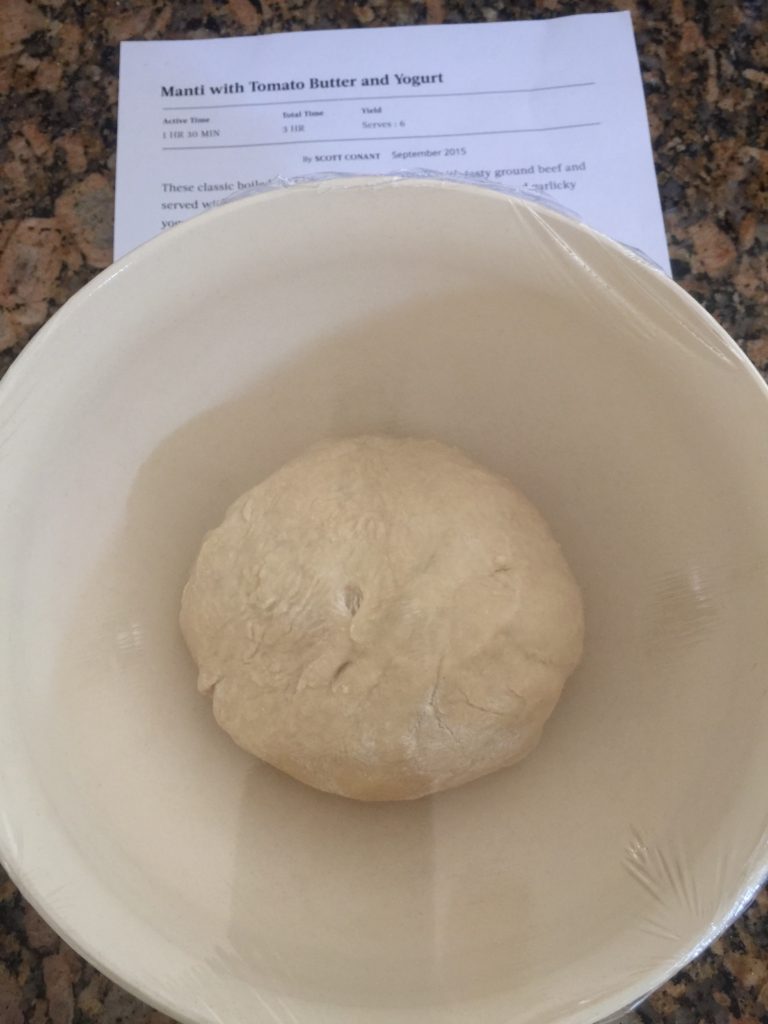
Manti dough. 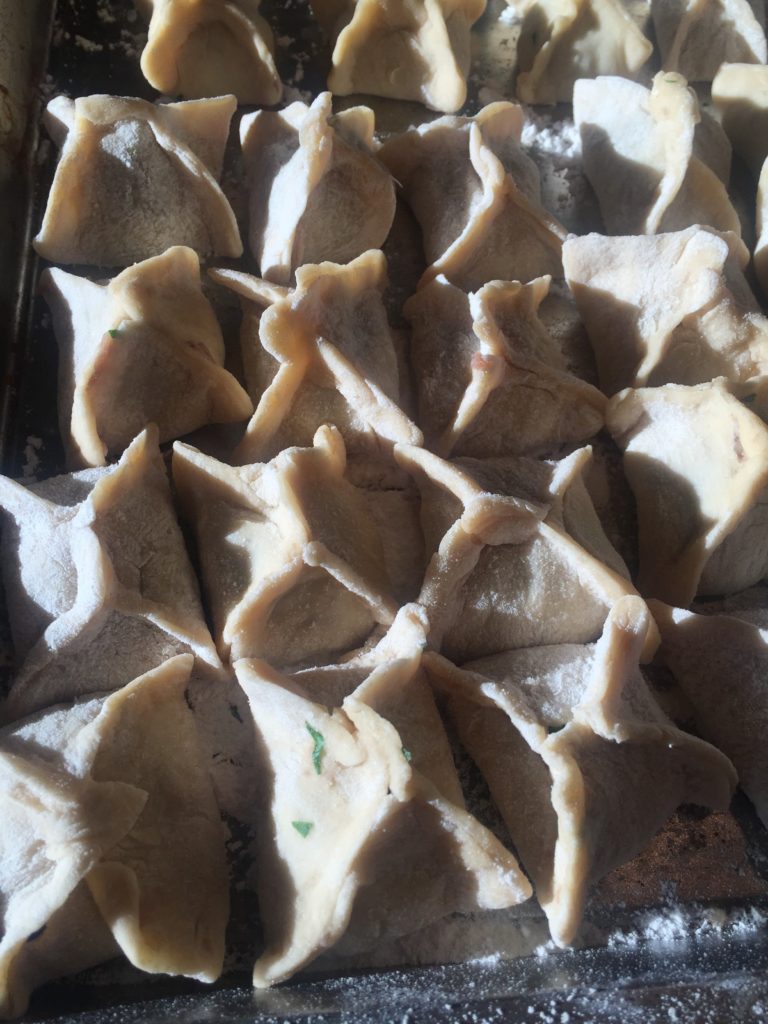
Manti ready to cook. 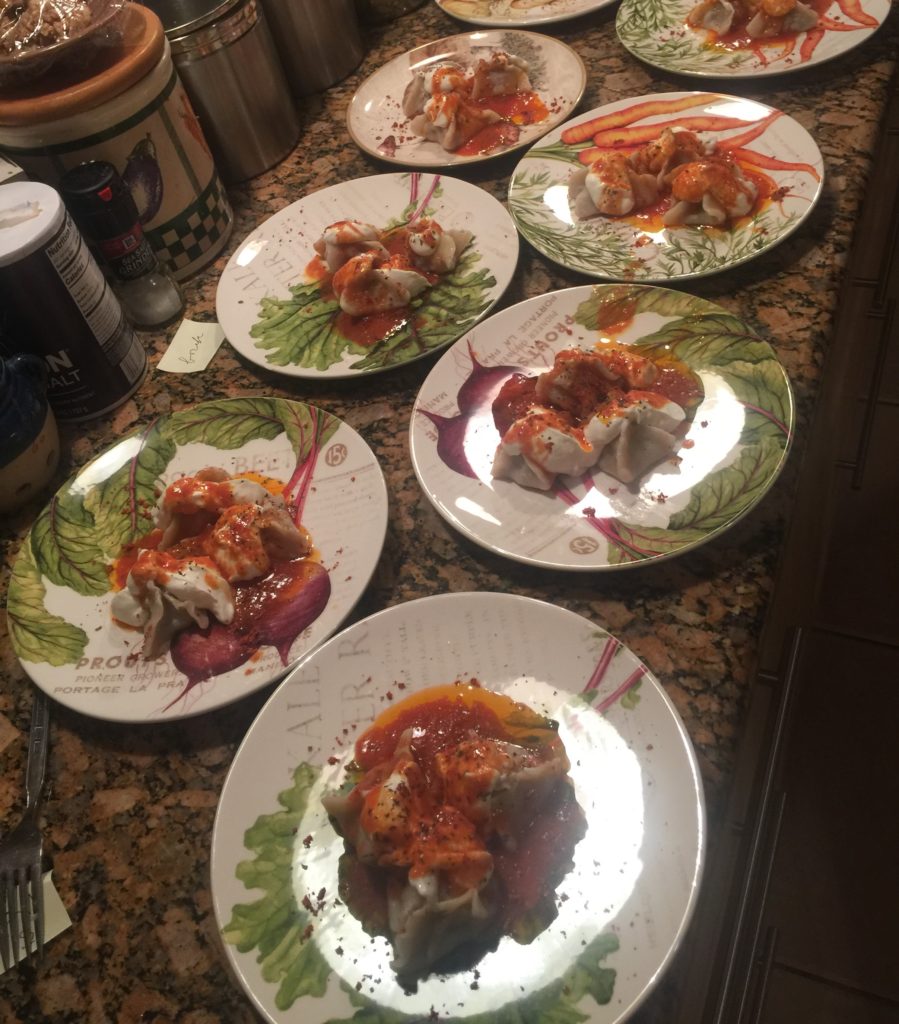
Assembly line. 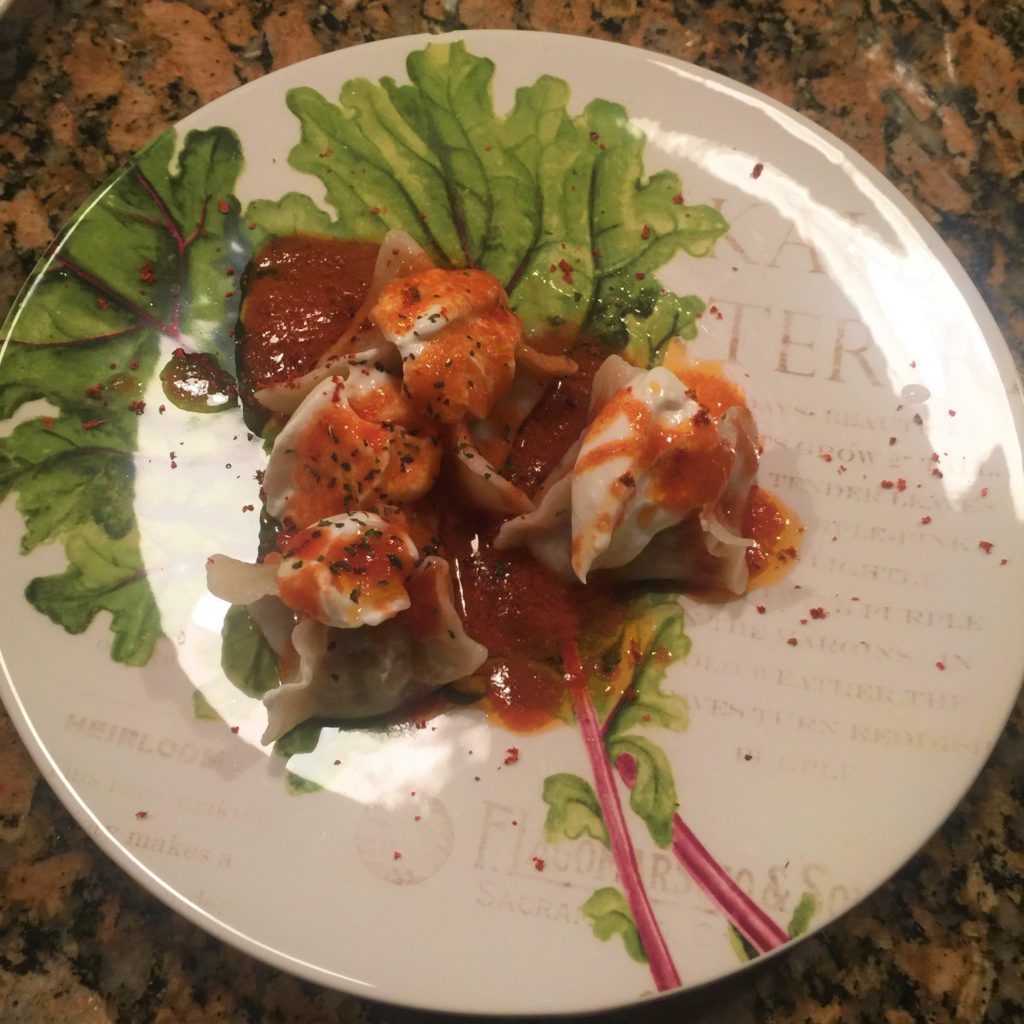
Manti garnished and ready!
Since there was a positive response to manti when served at our previous Turkish wine dinner, I decided it deserved a second appearance at one of our forkandcorkdivine wine dinners. This version of manti is a classic boiled Turkish dumpling filled with ground beef, then served with a garlicky yogurt sauce and a smoky tomato butter sauce.
First step is to prepare the dough from flour, egg and a bit of salt, then knead away till smooth for about 5 minutes and let it rest about 1 1/2 hours. Make the meat filling of ground beef (I used lamb for my first version), onions, parsley and seasoning. The really fun part is rolling out the dough as thinly as you can (1/16 inch is good), then cut in 2 inch squares and put a spoonful of meat in the center of each square. Fold the dough over on each square to make a little starlike “purse” then fold up the corners making sure they are sealed. I froze mine on a floured sheet pan and then pulled out of the freezer fairly close to when I was ready to cook. Once again this is a good dish for such a dinner as you can make and freeze the manti days ahead! Make your sauces – the yogurt is cold, and the tomato butter can be reheated lightly on the stove. Be sure to get your pot of salted water boiling in advance, so you are not standing at your stove waiting for a boil while your guests wait patiently for your next course! It’s happened to me!! Cook and plate, add your sauces and garnish with dried or fresh chopped mint and some Aleppo pepper is terrific. The bottom line is that this dish was perfect with our Turasan Kalecik Karasi wine for Stop #5 in Turkey.
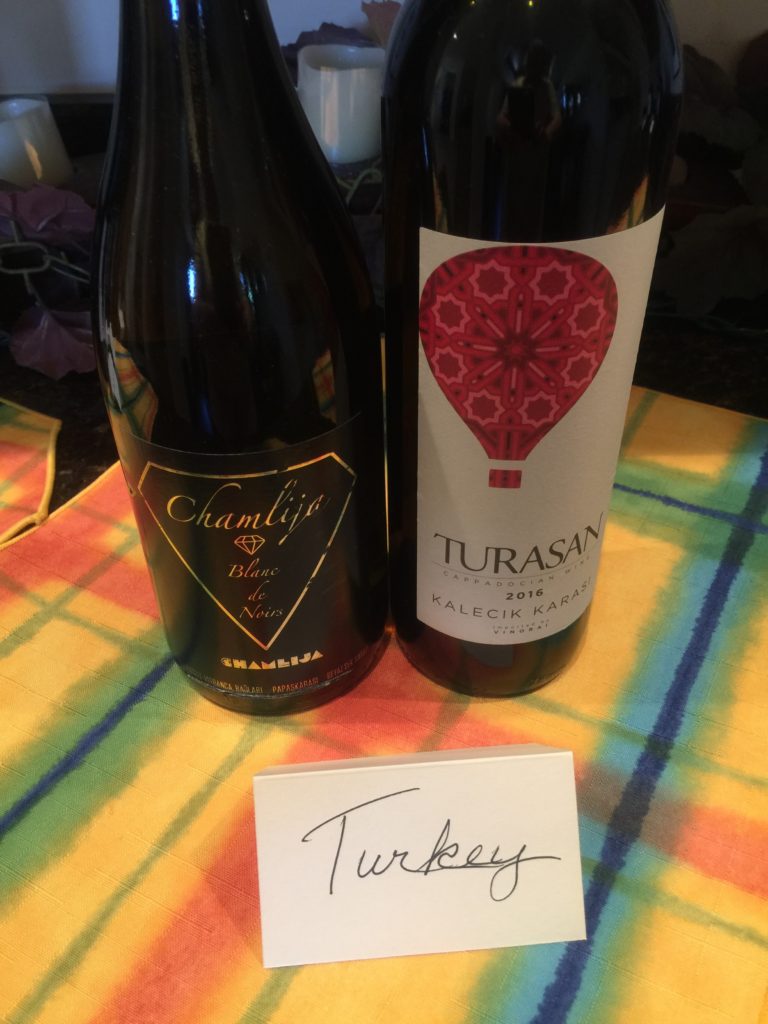
2016 Turasan Kalecik Karasi, Cappadocia, Turkey
Turasan has been making wine for 3 generations in Cappadocia, the home of the troglodyte cave dwellers and fairy chimney rock formations. Winemaking has been going on in Cappadocia for more than 7,000 years including the Hittites, Byzantines and the Turks. Emir is a native white grape grown here along with an indigenous red, Kalecik Karasi. This winery owned by Hasan Turasan was the first privately established winery in the region and they are considered a 70 plus year legend. We drank a bottle of Turasan Emir at our previous Turkish wine dinner. There were 2000 cases of this 2016 Turasan Kalecik Karasi produced by dry farming in volcanic tuff soil, vinified in stainless steel and concrete tanks, then bottled after 5 months. Our wine was red fruit-forward with low to medium tannins, bright acidity, aromas of red fruit, raspberry, red currant and cherry. It is often compared to Pinot Noir and our guests really enjoyed it! Again I repeat: Stop #5 pairings were quite a success.
Note: Here are links to more information about the grapes and wines of Turkey and our previous wine dinner: https://www.forkandcorkdivine.com/?p=1570 and https://www.forkandcorkdivine.com/?p=1621
Stop #6 – Barb’s “Lebanon”
Kafta Kebabs
Seasoned ground lamb on a skewer served with pickled vegetables, Lebanese potato salad and pita bread
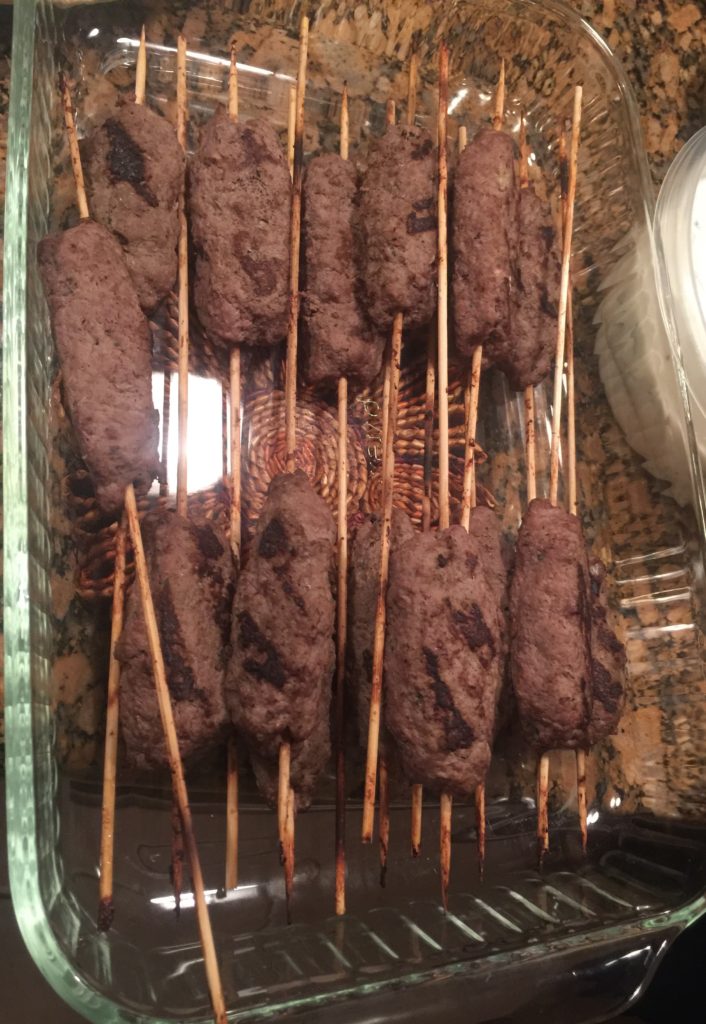
Kafta skewers –
lamb from Circle C Farm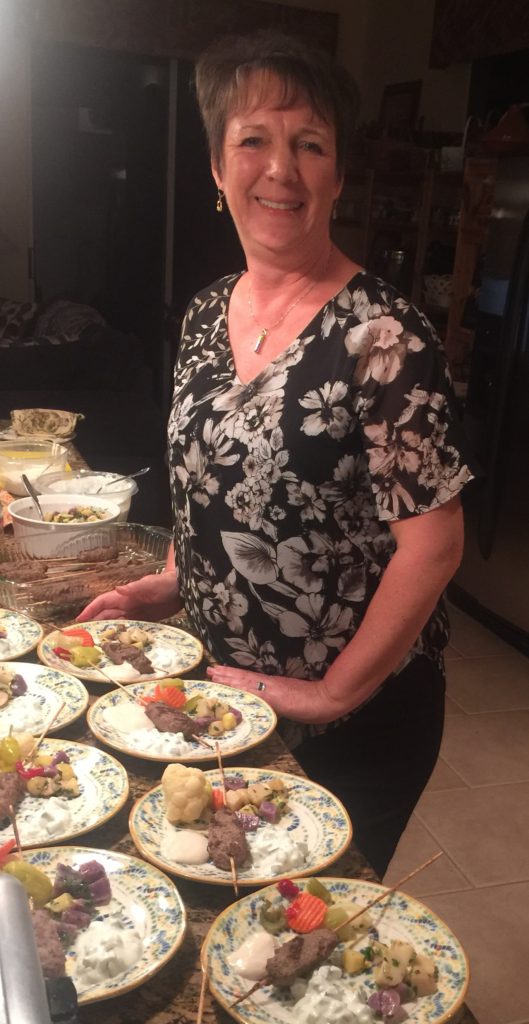
Barb plating her Lebanese cuisine.
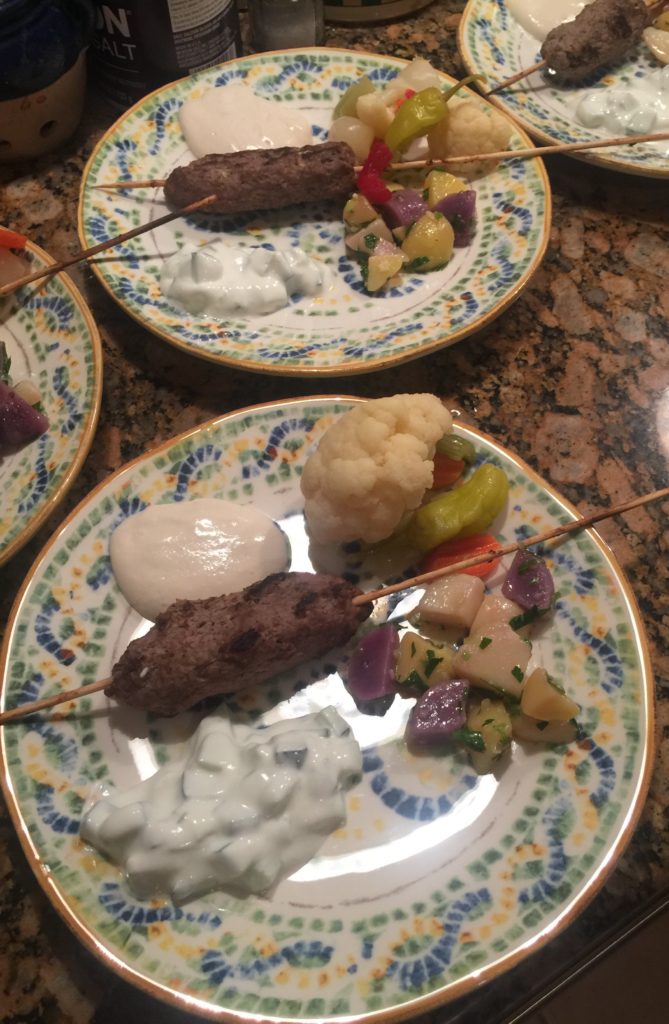
When our friend Barb opted to pair our Lebanese wines with appropriate food, she went in search of some authentic recipes from Julie Taboulie’s “Lebanese Kitchen”. Julie has a wonderful cookbook full of flavorful Mediterranean home cooking recipes. She has also had a cooking show on public television. Barb decided to make Kafta Kababs, a street food star in Lebanese cooking. Barb bought some grass fed ground lamb from our local Circle C Farm, seasoned it well, and formed it into traditional long sausage-like shapes on skewers. She grilled the kababs and served them with pickled vegetables, Lebanese style potato salad, several dipping sauces and pita bread. The potato salad was made with gold, red and purple potatoes, scallions, herbs and a garlic vinaigrette dressing and added a really colorful presentation to the plate. Barb’s Lebanese street food was a delicious feast and well worthy of our Stop #6 wines.
2013 Massaya “Cap Est”, Red Rhone Blend, Bekaa Valley, Lebanon
Grenache noir 50%/Mourvedre 50%
Lebanon is another one of the oldest areas of wine production in the world dating back 5000 years ago to the Phoenicians. Religion always seems to play a big part in winemaking. Here it was Islamic Muslim rule that prohibited the use of alcohol; however Christians and Jews still made wine for sacramental and medicinal use. Jesuits planted grapevines in the Bekaa Valley which later became Chateau Ksara, the country’s first commercial winery. French winemakers have a big influence due to French occupation after WWI. Winemaking in Lebanon is especially challenging due to geopolitical struggles in this area of the world. But Lebanon is perfectly suited for winegrowing due to warm sunny days, cool nights, and soil of lime and red clay with a gravely mix in the mountain vineyards. The grapes are on French rootstock and widely consist of French varietals: Cabernet Sauvignon, Syrah, Merlot, Cinsault, Chardonnay, Carignan, Mourvedre, Viognier and Grenache.
The Ghosn family, owners of the boutique Massaya Winery, was forced to leave Lebanon in the 1970s, but Sami and his brother Ramzi returned to the family estate in the mid 1990s. Sami will tell you how he had to sleep on the roof of their old home with an AK47 for 4 months before he successfully removed squatters from his home. Sami and Ramzi started making Arak, an ouzo-like spirit by 1994 and now export red, white and rosé wine to over 20 countries. They became partners early on with the owners of Vieux Telegraphe and Cheval Blanc which surely had an impact on their wines. Not bad partners to have in the wine business!
The 2013 Massaya “Cap Est” is a Red Rhone blend of 50% Grenache and 50% Mourvedre from 17 acres on the hillsides of the northeastern Bekaa Valley in the Ras Baalbeck area. The wines spent 22 months in oak vats and were bottled without fining or filtering at 2 years. It was an elegant pale ruby wine with subtle violets and ripe red berry fruits on the nose, minerality and fine tannins highlighting the terroir. This wine was just as good as I remembered it from our tasting with Sami Ghosn a few years back right here in Southwest Florida.
2015 Chateau Musar “Hochar Pere et Fils” Red Blend, Bekaa Valley, Lebanon
Cinsault 50%/Grenache 35%/Cabernet Sauvignon 15%
Chateau Musar is located in Ghazir 24 km north of Beirut. Their 180 hectares of vineyards grow mainly in the Bekaa Valley, 40 km east of Beirut, and were the first to become organically certified in Lebanon in 2006. The Musar vineyards are so remote and unspoiled that they could have been considered “organic” by default before there was such a term. All the grapes are hand-harvested by local Bedouins between August and October. Ambient yeasts do the work of fermentation. Bare minimum amounts of sulphur is used and the reds are neither fined nor filtered. They produce 58,000 cases a year from Cinsault, Carignan, Cabernet Sauvignon, Syrah, Grenache, Obaideh (a native Chardonnay), Merwah (a native variant of Semillion), Chardonnay, Viognier and Vermentino.
The Hochar Pere et Fils is sourced from specially selected vineyards with deep gravelly soil over limestone base. Low yields keep the wine concentrated. The 2015 Chateau Musar “Hochar” is a blend of 50% Cinsault, 35% Grenache and 15% Cabernet Sauvignon which was macerated in cement vats followed by 6 months in French Nevers oak barrels. Our bottle of Hochar was bright ruby red with red fruits on the nose, bitter sweet cherries and a hint of dark chocolate followed by sweet spicy notes on the palate. The tannins were soft with a long finish. This was a really nice well rounded red blend and we enjoyed it. Stop #6 – another success!
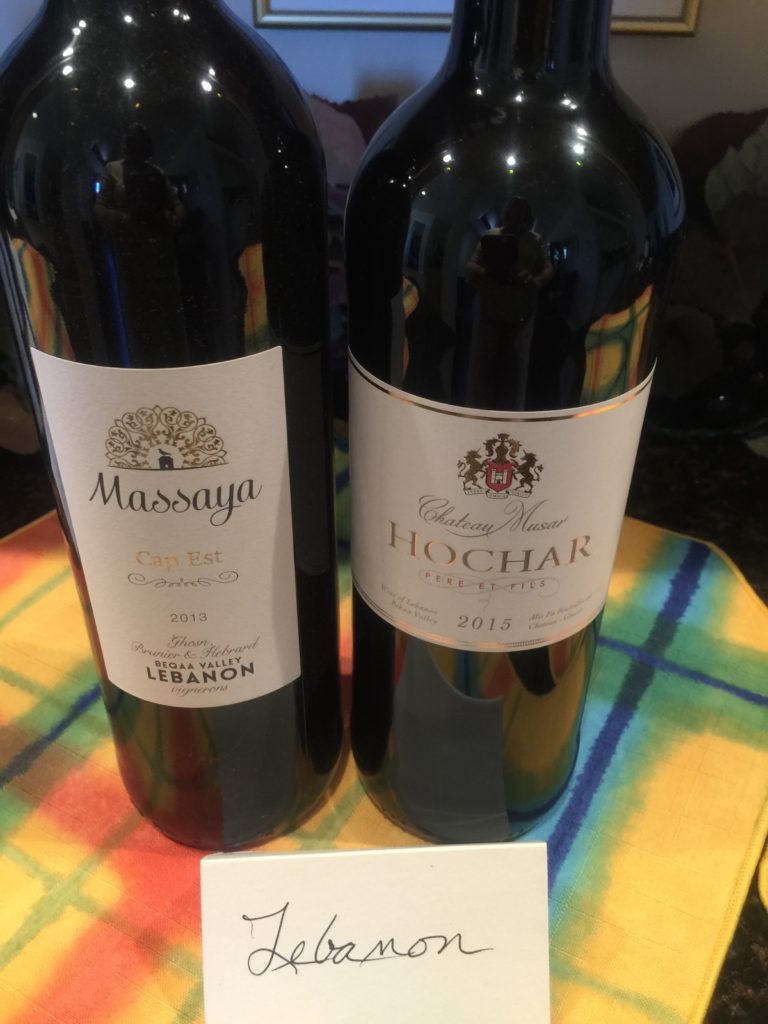
Stop #7 – Donna’s “Israel”
Sambuska – A savory cheese-filled Middle Eastern turnover pastry
Sambuska can be filled with chickpeas, ground meat, cheese or potatoes and make great little appetizers. You can even prepare them ahead and keep some in the freezer. They cross many cultural lines and are ancestors to samosas, empanadas and calzones. They are traditionally fried, but you can also bake them. Donna opted to make the cheese version, filled with a mixture of kashkaval and feta cheese. Once again this is a perfect item for a dinner like ours, since Donna was able to make them ahead, transport them and just warm them a bit before serving. They were a perfect accompaniment to our two Israeli wines. Another great course – Stop #7.
2014 Binyamina “Yogev” Cabernet Sauvignon-Shiraz, Israel
92 pt WE/Editor’s choice
According to many articles I have read, Israeli wines have been getting a “bad rap” for many years. Just like all of the other countries in that part of the world, they have been making wine forever. The Middle East is the historic birthplace of wine, but with a wealth of young winemakers looking toward the future, modern winemaking really took off in Israel in the 1970s. So who made this happen? Baron Edmond de Rothschild, owner of the famed Chateau Lafite Rothschild in Bordeaux is heralded as the father of modern winemaking in Israel. Now there are approximately 300 wineries in Israel, some small and some large. The four largest are Barkan, Carmel, Teperberg and Golan Heights who together make more than 20 million bottles a year. Most Israeli wine produced is kosher; however some small wineries make non-kosher wine. The US is the largest export market for Israeli wines which are made from Cabernet Sauvignon, Merlot, Syrah, Grenache, Carignan, Chardonnay, Chenin Blanc and Sauvignon Blanc.
Binyamina Winery is the fifth largest in Israel and produces about 2.8 million bottles a year. It was founded in 1952 and used to make mainly sweet and table wines. Some investors bought it in 1994 who invested in new vineyards and technology until it was purchased by a supermarket chain. Their two well-educated winemakers make wine in four major labels. The “Yogev” or “farmer” series was created to honor the people who grow the grapes. There are six wines in the series and all are blends.
Our 2014 Yogev Samson Cabernet Sauvignon (60%) – Shiraz (40%) was selected by Wine Enthusiast as the #33 wine of their 2018 Top 100 and awarded 92 points. It was inky-purple with cherry and orange zest on the nose, rich tannins and flavors of currant, raspberry, chocolate, flint and coffee. Our guests agreed it was a good drinking well-balanced bottle.
2014 Golan Heights Winery “Yarden” Cabernet Sauvignon, Upper Galilee, Israel
91 pts WE/WS/ #87 Wine Spectator Top 100 of 2018
Golan Heights Winery was founded in 1983 and has played a significant role in Israel’s current wine culture and the addition of Israeli wine to the world wine map. They currently produce four labels with a range of varieties and styles: Yarden, Gamla, Hermon and Golan. They practice sustainable agriculture and use solar power. Our bottle of 2014 “Yarden” Cabernet Sauvignon was New World in character with big, bold fruit, quite a bit of oak and 14.5% alcohol. We got the blackberry and violet aromas, and wild berry, toffee, anise, nutmeg and ginger flavors that we were told to expect. The finish was soft with notes of mocha. This Israeli wine was another winner with a 91 point rating from Wine Enthusiast and #87 on Wine Spectator’s Top 100 of 2018. We look forward to tasting more Israeli wine in the future.
Final Stop – A Sweet Ending
Hungarian Kifli Puffs
Nena’s Croatian Sour Cherry Cake
I don’t care how many other courses there are! Every good wine dinner MUST have a sweet ending!! I decided to try my luck with Hungarian kifli puffs. These are delicate, nutty, lightly sweet pastries baked until crispy. My recipe looked fairly simple and called for purchased frozen puff pastry. I can work with that. Pulse a lot of walnuts in the food processor until finely chopped and mix with some sugar. For the pastry, thaw it out and roll lightly to make enough space for 8 equal pieces. Put a little scoop of nuts in the middle of each and fold the cornersNen of each into a little package and bake. I’m happy to report that my kifli puffs looked just like the picture in the recipe! And just as our guests predicted, they tasted really good the next morning with a cup of coffee!!
If one dessert is good, two is MUCH better. Nena’s Croatian Sour Cherry Cake recipe filled the bill. I could fold beaten egg whites into to the initial batter just as instructed. The biggest challenge was finding the required sour cherries. My supermarket had no frozen or canned sour cherries, only sweet. I was about to give up and make plans to visit several other stores when I discovered dried sour cherries in the specialty foods area of the produce section. Hooray! Just add water, heat a bit to rehydrate, and the sour cherries are ready to use. Bake your cake in a 10 inch round pan for 5 minutes, then very carefully place the cherries around the surface of the cake and finish baking. Perfection! Serve with some fresh whipped cream for some happy guests.
2016 Royal Tokaji Late Harvest, Hungary 94 pts WE
A blend of Furmint, Hárslevelü and Yellow Muscat
The Royal Tokaji Wine Company was founded in Hungary in 1990. They focus on single-vineyard wines made from first growth vineyards. Royal Tokaji was inspired and founded by Hugh Johnson, the legendary author and wine historian, with a goal to reclaim the region as one of the most renowned. The wines have already won over 100 international awards, so evidently Mr. Johnson is well on the way to meet his objective. Their portfolio of award winning wines includes Dry Furmint, Late Harvest, 5 and 6 Puttonyos blends, single vineyard Aszu wines and Essencia. The Tokaji wine region is 240 km northeast of Budapest in the Zemplen Mountains and was the first classified wine region in Europe.
The Late Harvest wine is a blend of Dry Furmint with Harslevelu and Yellow Muscat grapes that were harvested between October 28 and November 4, destemmed and macerated overnight, then pressed for 2-3 days before racking. It fermented in the tank followed by 2-3 months in the barrel. Our 2016 had aromas of acacia flowers and pears, with flavors of apricots, pear juice and dried rosemary. Wine Enthusiast scored it 94 points and so did we!
Maraska Maraschino Liqueur, Croatia
Maraschino is a liqueur made by distilling Marasca cherries. They are the small slightly sour fruit of the Marasca cherry tree which grows wild along parts of the Dalmation coast in Croatia. The cherries and crushed cherry pits are processed and distilled similar to brandy. It is 32% alcohol, 64 proof, produced and bottled by Maraska in Zadar, Croatia. It made a very sweet ending!
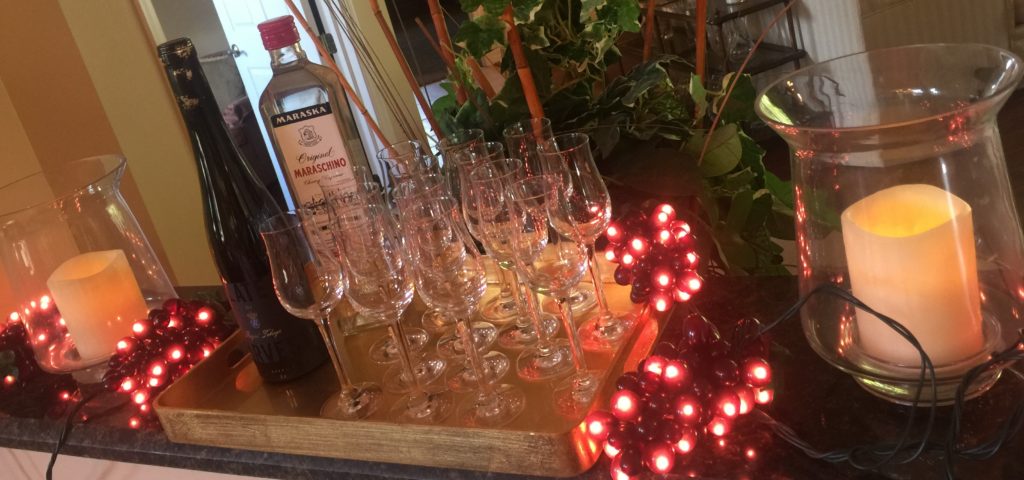
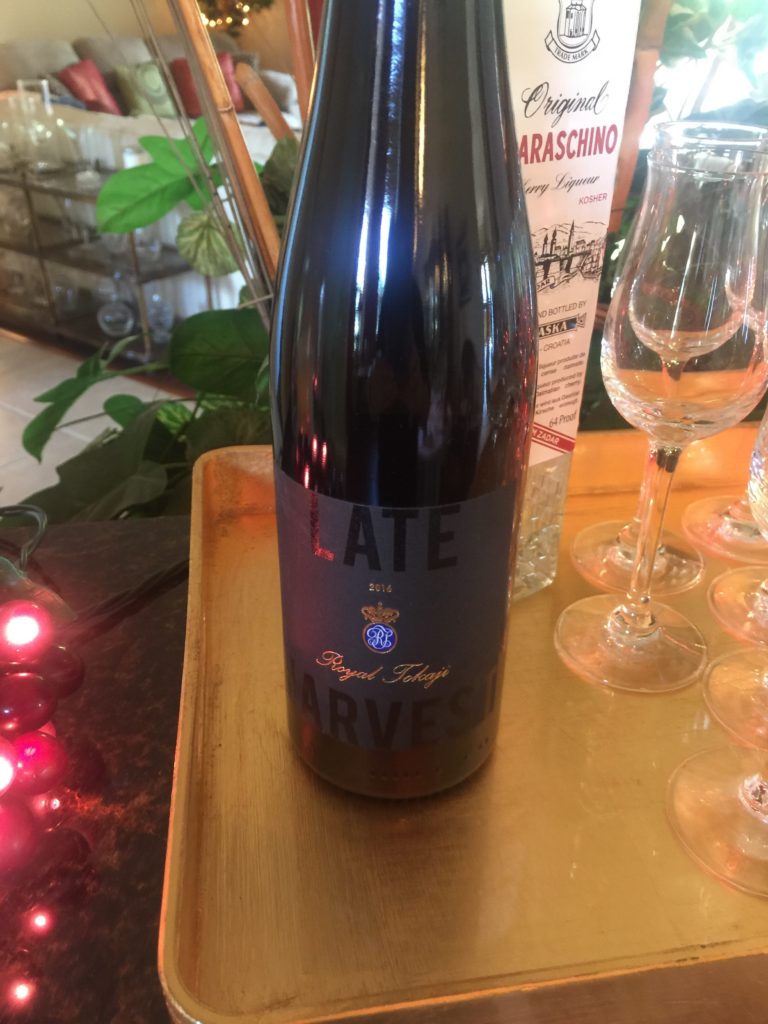
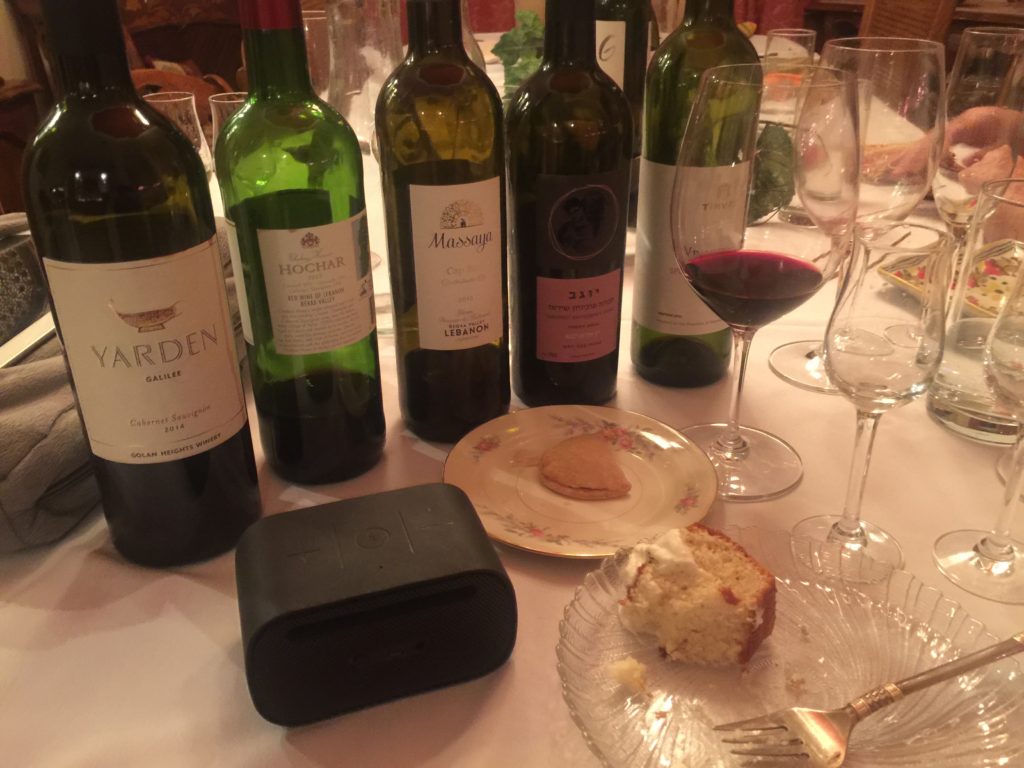
The hostess trying to “catch up”! Of course, I’m also the photographer. 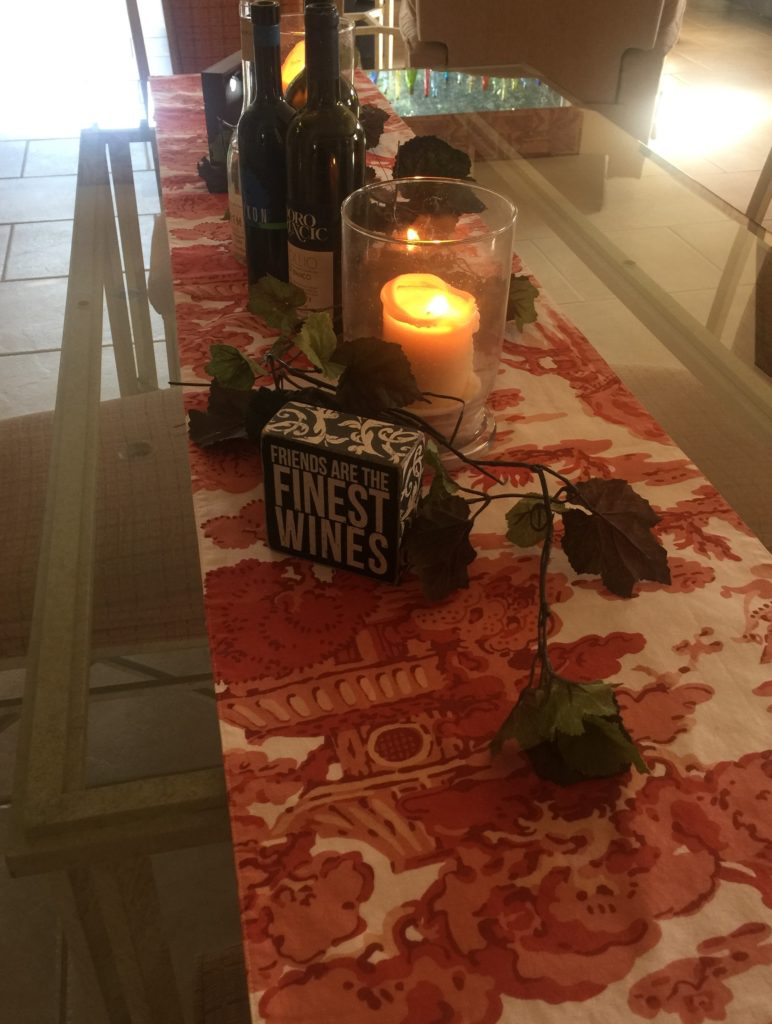
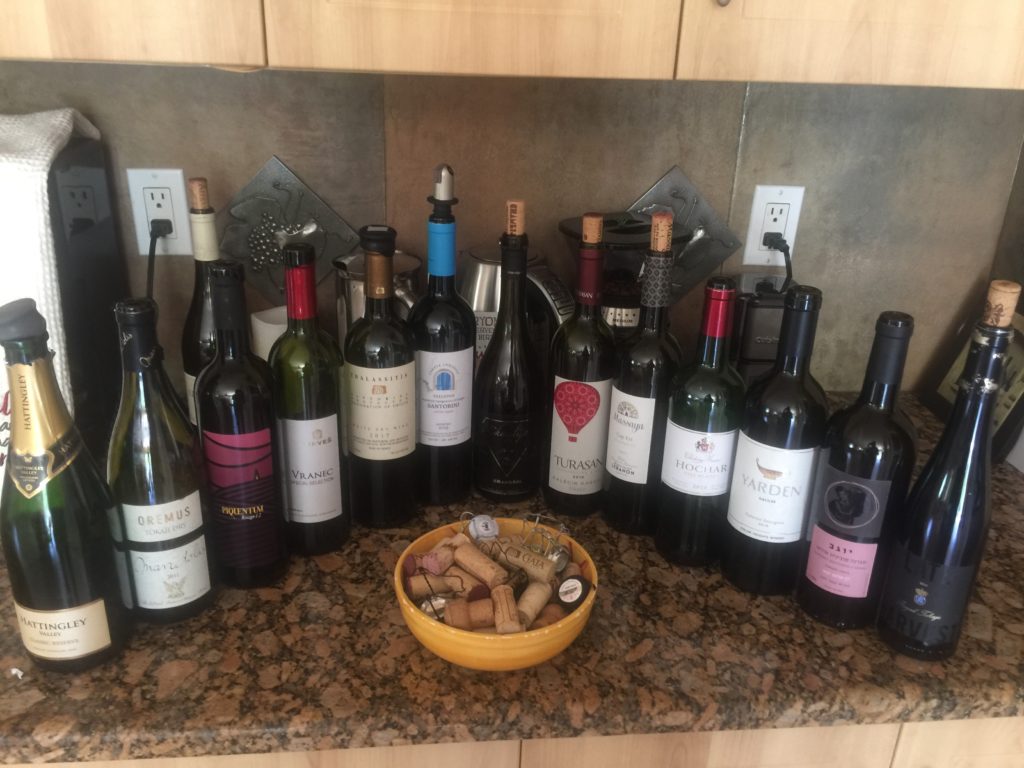
No longer left alone on the shelf! They are now famous. 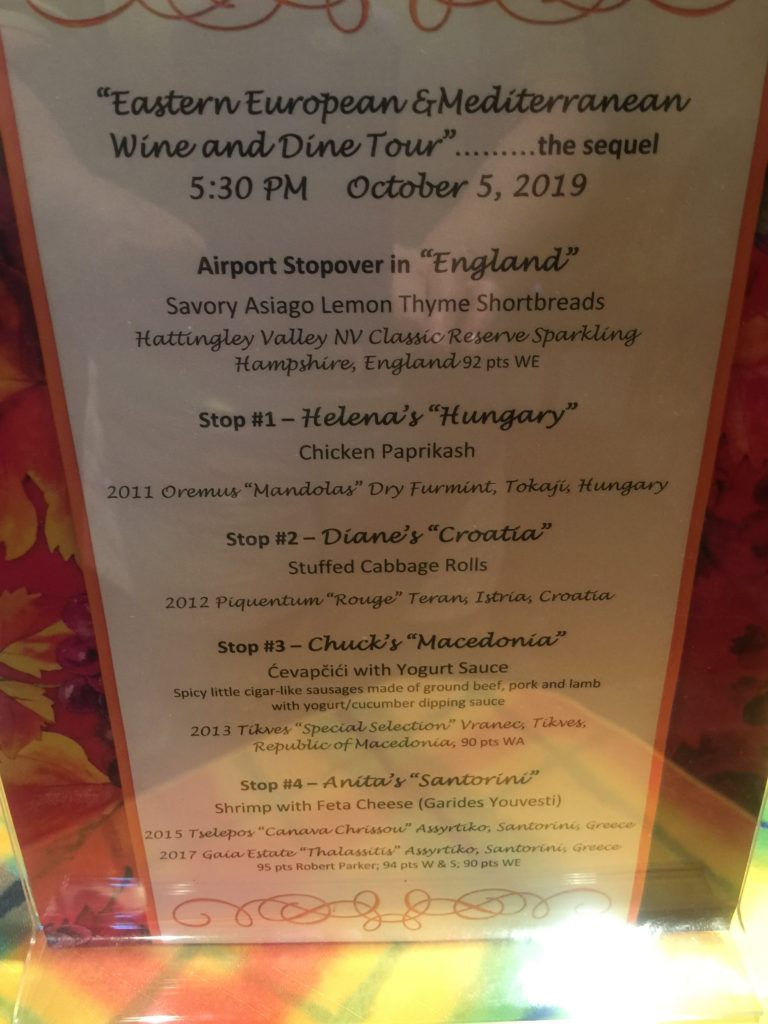
Guest menu page 1 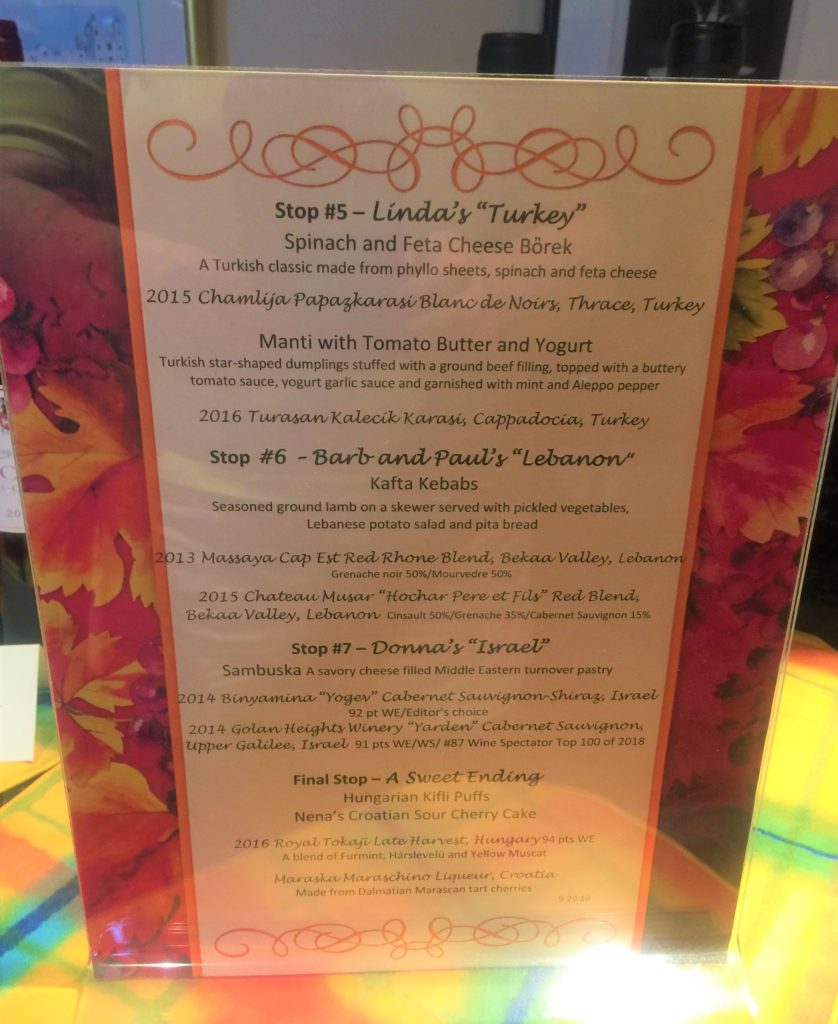
Guest menu page 2
After each wine dinner, I reflect upon how lucky I am to have a husband and winelover foodie friends who are willing to assist and take part in the experience. Without them, none of these amazing experiences would ever happen! This evening’s adventure was truly another of epic proportions and was numerous months in the making.
A group of eight winelover foodie friends made a whirlwind tour of seven countries in Eastern Europe and the Eastern Mediterranean in just about five hours. We tasted twelve wines paired with food appropriate for each country or wine region. We even had a bonus of sparkling wine from England and a liqueur from Croatia.
Did we vote on or select any favorites? They are all my personal favorites depending upon the time and place, food served and other guests tasting. I did hear some indications throughout the evening of extra special wine appreciation, but it would be hard to pick a winner! I am ecstatic to have been able to share them.
Our “lonely leftover” wines from the CellarTracker inventory got their chance to shine like the superstars they are. And we were so happy to share them with people who appreciate them. A number of those wines were purchased some years back when I discovered a couple of wine purveyors who sold wines from less familiar countries like Croatia, Slovenia and Turkey. I am so grateful to have had the opportunity to purchase and taste them because those companies have now closed their doors or will do so shortly. Blue Danube Wine Company was a favorite of mine, and I just recently received notice from them that they are retiring and will no longer be in business by the end of the year. On the positive side, several new companies have begun to appear. For example Blue Ice US is now offering some wines from Croatia and Slovenia. While their portfolio is still fairly small, it is a good start. Who knows how the import wine industry will fare in the future? We will just have to wait and see. In the meantime, taste as many “new to you” wines as you can! Life is too short to pass up any opportunities to drink adventurously, and we have proved over and over that you don’t even need to leave the comfort of your home. Cheers!
10.14.19

